Assessing Knowledge of Child Sexual Abuse Among Parents in Devdaha Municipality
VerifiedAdded on 2021/10/27
|22
|4671
|343
AI Summary
This study aims to assess the knowledge of parents in Devdaha Municipality regarding child sexual abuse. The study will provide insights into the prevalence of child sexual abuse and the association between knowledge levels and socio-demographic variables. The study will be conducted as a descriptive cross-sectional study and will use structured questionnaires to collect data. The study will be helpful to the management of Devdaha municipality to make plans regarding awareness programs on child sexual abuse.
Contribute Materials
Your contribution can guide someone’s learning journey. Share your
documents today.
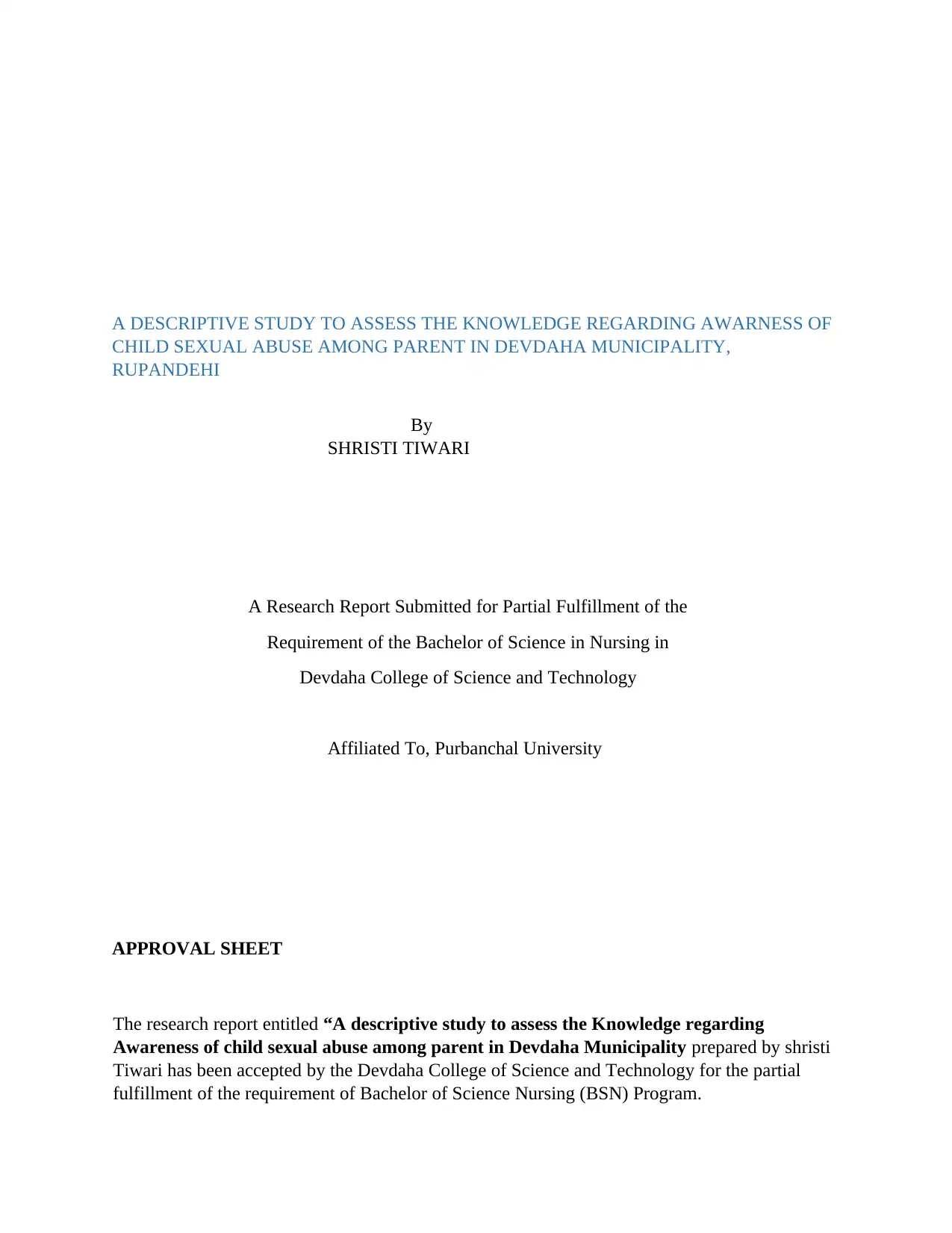
A DESCRIPTIVE STUDY TO ASSESS THE KNOWLEDGE REGARDING AWARNESS OF
CHILD SEXUAL ABUSE AMONG PARENT IN DEVDAHA MUNICIPALITY,
RUPANDEHI
By
SHRISTI TIWARI
A Research Report Submitted for Partial Fulfillment of the
Requirement of the Bachelor of Science in Nursing in
Devdaha College of Science and Technology
Affiliated To, Purbanchal University
APPROVAL SHEET
The research report entitled “A descriptive study to assess the Knowledge regarding
Awareness of child sexual abuse among parent in Devdaha Municipality prepared by shristi
Tiwari has been accepted by the Devdaha College of Science and Technology for the partial
fulfillment of the requirement of Bachelor of Science Nursing (BSN) Program.
CHILD SEXUAL ABUSE AMONG PARENT IN DEVDAHA MUNICIPALITY,
RUPANDEHI
By
SHRISTI TIWARI
A Research Report Submitted for Partial Fulfillment of the
Requirement of the Bachelor of Science in Nursing in
Devdaha College of Science and Technology
Affiliated To, Purbanchal University
APPROVAL SHEET
The research report entitled “A descriptive study to assess the Knowledge regarding
Awareness of child sexual abuse among parent in Devdaha Municipality prepared by shristi
Tiwari has been accepted by the Devdaha College of Science and Technology for the partial
fulfillment of the requirement of Bachelor of Science Nursing (BSN) Program.
Secure Best Marks with AI Grader
Need help grading? Try our AI Grader for instant feedback on your assignments.
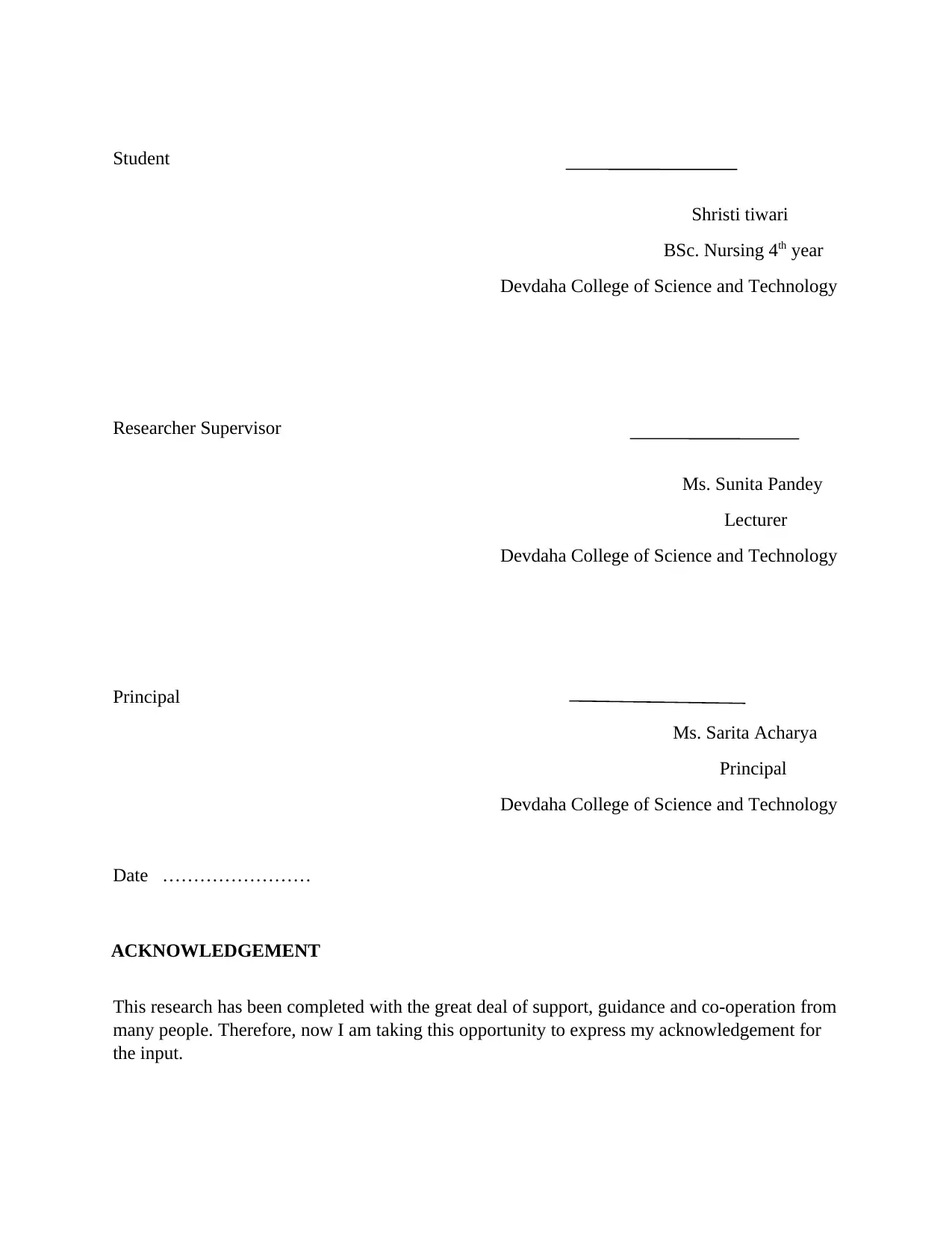
Student
Shristi tiwari
BSc. Nursing 4th year
Devdaha College of Science and Technology
Researcher Supervisor
Ms. Sunita Pandey
Lecturer
Devdaha College of Science and Technology
Principal
Ms. Sarita Acharya
Principal
Devdaha College of Science and Technology
Date ……………………
ACKNOWLEDGEMENT
This research has been completed with the great deal of support, guidance and co-operation from
many people. Therefore, now I am taking this opportunity to express my acknowledgement for
the input.
Shristi tiwari
BSc. Nursing 4th year
Devdaha College of Science and Technology
Researcher Supervisor
Ms. Sunita Pandey
Lecturer
Devdaha College of Science and Technology
Principal
Ms. Sarita Acharya
Principal
Devdaha College of Science and Technology
Date ……………………
ACKNOWLEDGEMENT
This research has been completed with the great deal of support, guidance and co-operation from
many people. Therefore, now I am taking this opportunity to express my acknowledgement for
the input.
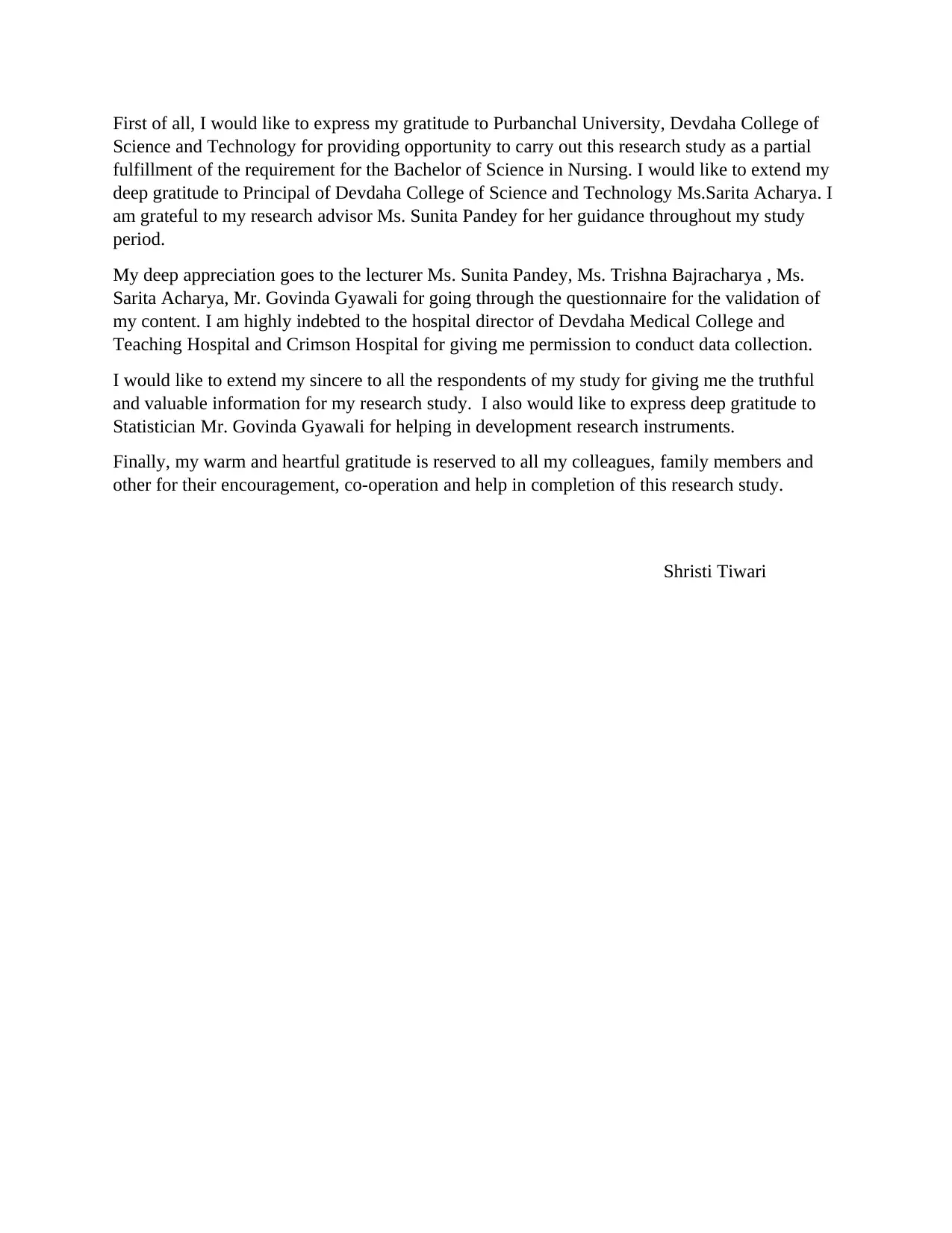
First of all, I would like to express my gratitude to Purbanchal University, Devdaha College of
Science and Technology for providing opportunity to carry out this research study as a partial
fulfillment of the requirement for the Bachelor of Science in Nursing. I would like to extend my
deep gratitude to Principal of Devdaha College of Science and Technology Ms.Sarita Acharya. I
am grateful to my research advisor Ms. Sunita Pandey for her guidance throughout my study
period.
My deep appreciation goes to the lecturer Ms. Sunita Pandey, Ms. Trishna Bajracharya , Ms.
Sarita Acharya, Mr. Govinda Gyawali for going through the questionnaire for the validation of
my content. I am highly indebted to the hospital director of Devdaha Medical College and
Teaching Hospital and Crimson Hospital for giving me permission to conduct data collection.
I would like to extend my sincere to all the respondents of my study for giving me the truthful
and valuable information for my research study. I also would like to express deep gratitude to
Statistician Mr. Govinda Gyawali for helping in development research instruments.
Finally, my warm and heartful gratitude is reserved to all my colleagues, family members and
other for their encouragement, co-operation and help in completion of this research study.
Shristi Tiwari
Science and Technology for providing opportunity to carry out this research study as a partial
fulfillment of the requirement for the Bachelor of Science in Nursing. I would like to extend my
deep gratitude to Principal of Devdaha College of Science and Technology Ms.Sarita Acharya. I
am grateful to my research advisor Ms. Sunita Pandey for her guidance throughout my study
period.
My deep appreciation goes to the lecturer Ms. Sunita Pandey, Ms. Trishna Bajracharya , Ms.
Sarita Acharya, Mr. Govinda Gyawali for going through the questionnaire for the validation of
my content. I am highly indebted to the hospital director of Devdaha Medical College and
Teaching Hospital and Crimson Hospital for giving me permission to conduct data collection.
I would like to extend my sincere to all the respondents of my study for giving me the truthful
and valuable information for my research study. I also would like to express deep gratitude to
Statistician Mr. Govinda Gyawali for helping in development research instruments.
Finally, my warm and heartful gratitude is reserved to all my colleagues, family members and
other for their encouragement, co-operation and help in completion of this research study.
Shristi Tiwari
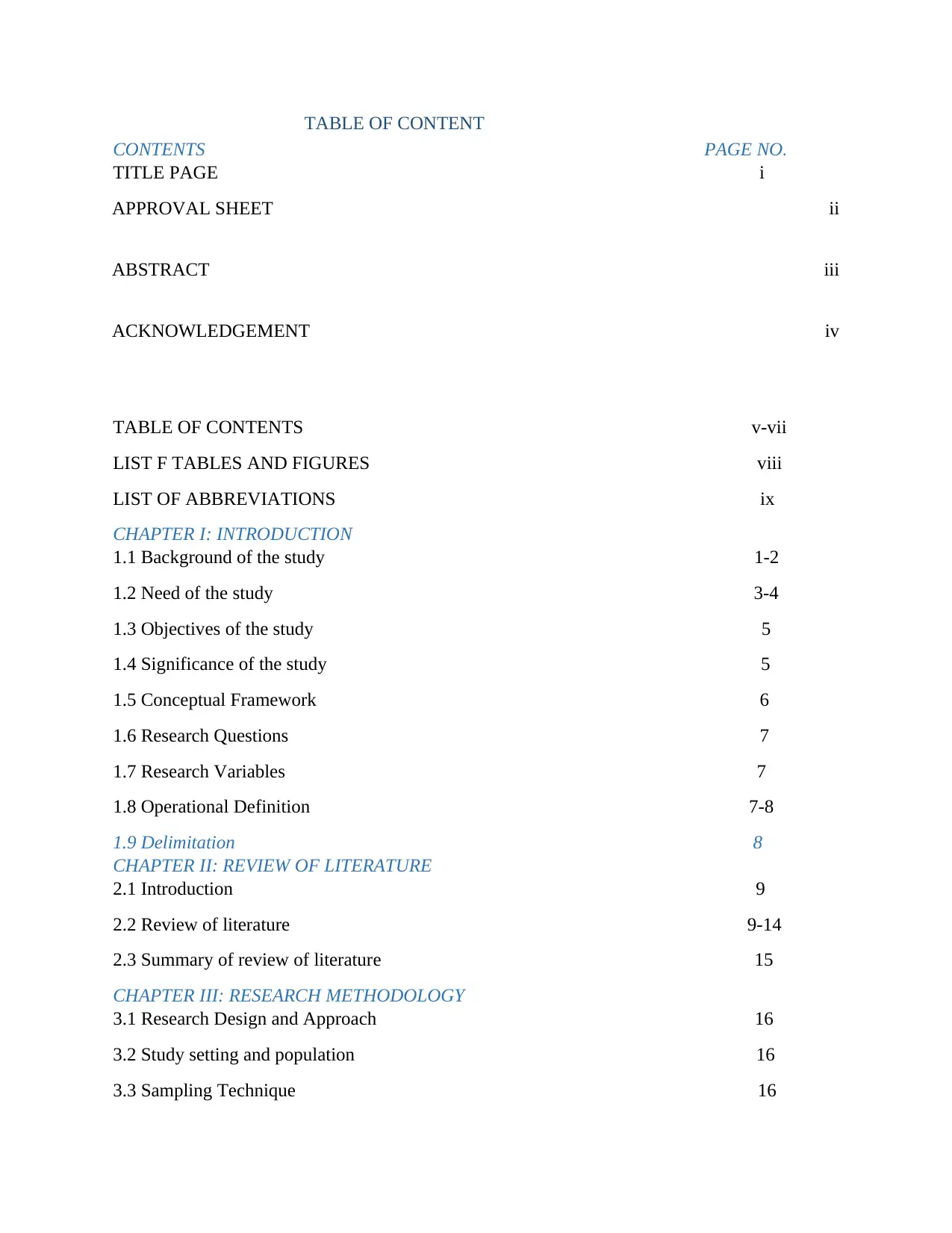
TABLE OF CONTENT
CONTENTS PAGE NO.
TITLE PAGE i
APPROVAL SHEET ii
ABSTRACT iii
ACKNOWLEDGEMENT iv
TABLE OF CONTENTS v-vii
LIST F TABLES AND FIGURES viii
LIST OF ABBREVIATIONS ix
CHAPTER I: INTRODUCTION
1.1 Background of the study 1-2
1.2 Need of the study 3-4
1.3 Objectives of the study 5
1.4 Significance of the study 5
1.5 Conceptual Framework 6
1.6 Research Questions 7
1.7 Research Variables 7
1.8 Operational Definition 7-8
1.9 Delimitation 8
CHAPTER II: REVIEW OF LITERATURE
2.1 Introduction 9
2.2 Review of literature 9-14
2.3 Summary of review of literature 15
CHAPTER III: RESEARCH METHODOLOGY
3.1 Research Design and Approach 16
3.2 Study setting and population 16
3.3 Sampling Technique 16
CONTENTS PAGE NO.
TITLE PAGE i
APPROVAL SHEET ii
ABSTRACT iii
ACKNOWLEDGEMENT iv
TABLE OF CONTENTS v-vii
LIST F TABLES AND FIGURES viii
LIST OF ABBREVIATIONS ix
CHAPTER I: INTRODUCTION
1.1 Background of the study 1-2
1.2 Need of the study 3-4
1.3 Objectives of the study 5
1.4 Significance of the study 5
1.5 Conceptual Framework 6
1.6 Research Questions 7
1.7 Research Variables 7
1.8 Operational Definition 7-8
1.9 Delimitation 8
CHAPTER II: REVIEW OF LITERATURE
2.1 Introduction 9
2.2 Review of literature 9-14
2.3 Summary of review of literature 15
CHAPTER III: RESEARCH METHODOLOGY
3.1 Research Design and Approach 16
3.2 Study setting and population 16
3.3 Sampling Technique 16
Secure Best Marks with AI Grader
Need help grading? Try our AI Grader for instant feedback on your assignments.
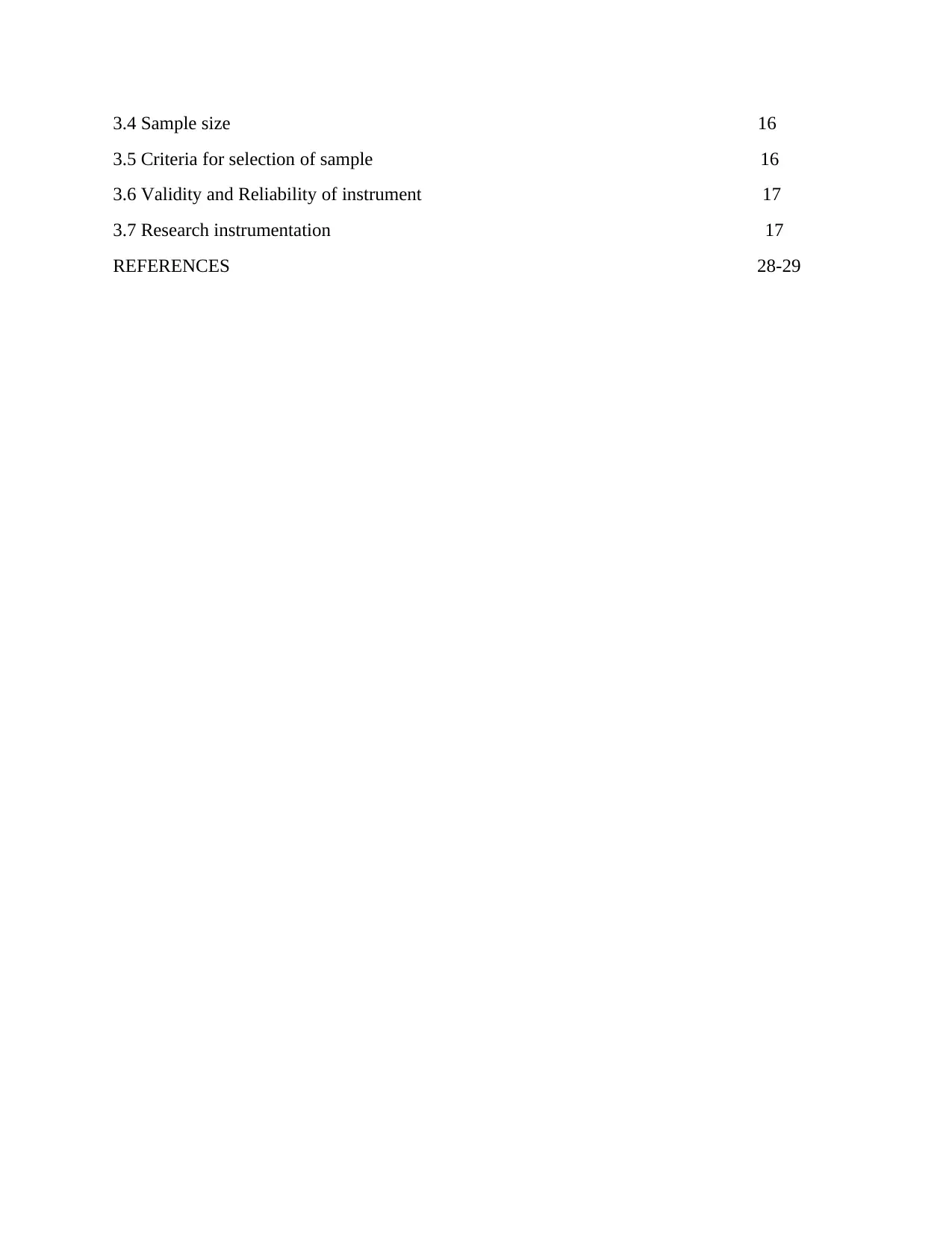
3.4 Sample size 16
3.5 Criteria for selection of sample 16
3.6 Validity and Reliability of instrument 17
3.7 Research instrumentation 17
REFERENCES 28-29
3.5 Criteria for selection of sample 16
3.6 Validity and Reliability of instrument 17
3.7 Research instrumentation 17
REFERENCES 28-29

CHAPTER I
INTRODUCTION
Background of the Study
Child abuse or maltreatment constitutes all forms of physical and/ or emotional illtreatment,
sexual abuse, neglect or negligent treatment or commercial or other exploitation, resulting in
actual or potential harm to the child’s health survival, development or dignity in the context of a
relationship of responsibility, trust or power (WHO , 2020).
Child sexual abuse is defined as the involvement of a child in sexual activity that he or she does
not fully comprehend, is unable to give informed consent to, or for which the child is not
developmentally prepared, or else that violates the laws or social taboos of society. Children can
be sexually abused by both adults and other children who are by virtue of their age or stage of
development in a position of responsibility, trust or power over the victim [World Health
Organization (WHO), 2006 ].
Child sexual abuse is a serious problem causing physical and psychosocial harm which leads to
negative short term and long-term consequences that affect children’s lives physically,
psychologically, socially, and developmentally (Alzoubi et al; 2018 ) .
The risk factors for sexual abuse are interparental violence, family isolation and residential
mobility, step father in home and parental problems including drug abuse, psychopathology and
a prior history of sexual abuse (Mccloskey & Bailey, 2000).
It is believed that when the child is able to recognize the abuse situation, and able to resist the
offender by saying no or running away, this may rescue him/her from being a victim of CSA.
So, it is anticipated that mothers who are aware about the nature of CSA and have adequate
knowledge about CSA signs and symptoms and its prevention strategies, are able to provide
their children with CSA prevention education that empower them and eventually protect their
children ( Alzoubi et al; 2018 ) .
INTRODUCTION
Background of the Study
Child abuse or maltreatment constitutes all forms of physical and/ or emotional illtreatment,
sexual abuse, neglect or negligent treatment or commercial or other exploitation, resulting in
actual or potential harm to the child’s health survival, development or dignity in the context of a
relationship of responsibility, trust or power (WHO , 2020).
Child sexual abuse is defined as the involvement of a child in sexual activity that he or she does
not fully comprehend, is unable to give informed consent to, or for which the child is not
developmentally prepared, or else that violates the laws or social taboos of society. Children can
be sexually abused by both adults and other children who are by virtue of their age or stage of
development in a position of responsibility, trust or power over the victim [World Health
Organization (WHO), 2006 ].
Child sexual abuse is a serious problem causing physical and psychosocial harm which leads to
negative short term and long-term consequences that affect children’s lives physically,
psychologically, socially, and developmentally (Alzoubi et al; 2018 ) .
The risk factors for sexual abuse are interparental violence, family isolation and residential
mobility, step father in home and parental problems including drug abuse, psychopathology and
a prior history of sexual abuse (Mccloskey & Bailey, 2000).
It is believed that when the child is able to recognize the abuse situation, and able to resist the
offender by saying no or running away, this may rescue him/her from being a victim of CSA.
So, it is anticipated that mothers who are aware about the nature of CSA and have adequate
knowledge about CSA signs and symptoms and its prevention strategies, are able to provide
their children with CSA prevention education that empower them and eventually protect their
children ( Alzoubi et al; 2018 ) .
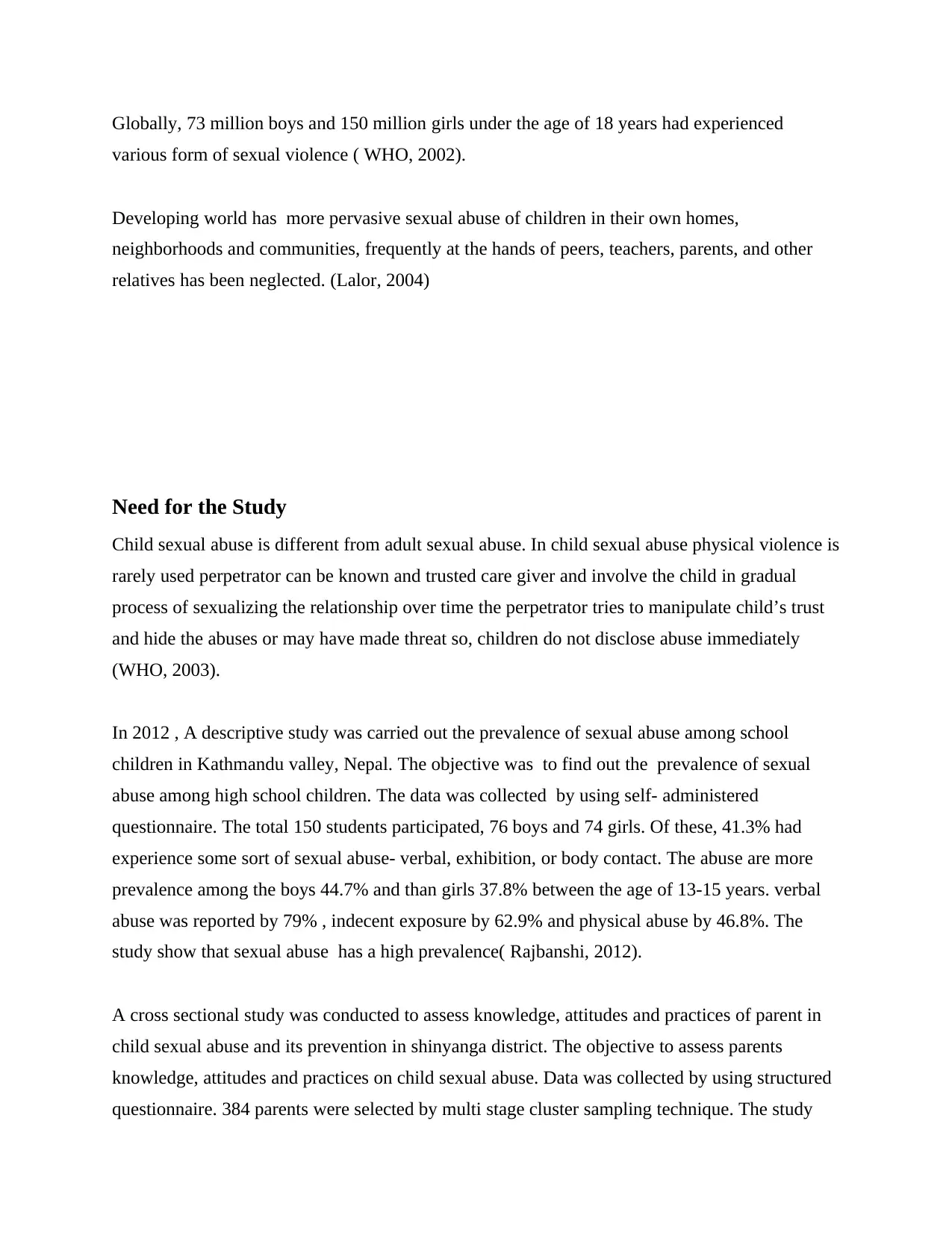
Globally, 73 million boys and 150 million girls under the age of 18 years had experienced
various form of sexual violence ( WHO, 2002).
Developing world has more pervasive sexual abuse of children in their own homes,
neighborhoods and communities, frequently at the hands of peers, teachers, parents, and other
relatives has been neglected. (Lalor, 2004)
Need for the Study
Child sexual abuse is different from adult sexual abuse. In child sexual abuse physical violence is
rarely used perpetrator can be known and trusted care giver and involve the child in gradual
process of sexualizing the relationship over time the perpetrator tries to manipulate child’s trust
and hide the abuses or may have made threat so, children do not disclose abuse immediately
(WHO, 2003).
In 2012 , A descriptive study was carried out the prevalence of sexual abuse among school
children in Kathmandu valley, Nepal. The objective was to find out the prevalence of sexual
abuse among high school children. The data was collected by using self- administered
questionnaire. The total 150 students participated, 76 boys and 74 girls. Of these, 41.3% had
experience some sort of sexual abuse- verbal, exhibition, or body contact. The abuse are more
prevalence among the boys 44.7% and than girls 37.8% between the age of 13-15 years. verbal
abuse was reported by 79% , indecent exposure by 62.9% and physical abuse by 46.8%. The
study show that sexual abuse has a high prevalence( Rajbanshi, 2012).
A cross sectional study was conducted to assess knowledge, attitudes and practices of parent in
child sexual abuse and its prevention in shinyanga district. The objective to assess parents
knowledge, attitudes and practices on child sexual abuse. Data was collected by using structured
questionnaire. 384 parents were selected by multi stage cluster sampling technique. The study
various form of sexual violence ( WHO, 2002).
Developing world has more pervasive sexual abuse of children in their own homes,
neighborhoods and communities, frequently at the hands of peers, teachers, parents, and other
relatives has been neglected. (Lalor, 2004)
Need for the Study
Child sexual abuse is different from adult sexual abuse. In child sexual abuse physical violence is
rarely used perpetrator can be known and trusted care giver and involve the child in gradual
process of sexualizing the relationship over time the perpetrator tries to manipulate child’s trust
and hide the abuses or may have made threat so, children do not disclose abuse immediately
(WHO, 2003).
In 2012 , A descriptive study was carried out the prevalence of sexual abuse among school
children in Kathmandu valley, Nepal. The objective was to find out the prevalence of sexual
abuse among high school children. The data was collected by using self- administered
questionnaire. The total 150 students participated, 76 boys and 74 girls. Of these, 41.3% had
experience some sort of sexual abuse- verbal, exhibition, or body contact. The abuse are more
prevalence among the boys 44.7% and than girls 37.8% between the age of 13-15 years. verbal
abuse was reported by 79% , indecent exposure by 62.9% and physical abuse by 46.8%. The
study show that sexual abuse has a high prevalence( Rajbanshi, 2012).
A cross sectional study was conducted to assess knowledge, attitudes and practices of parent in
child sexual abuse and its prevention in shinyanga district. The objective to assess parents
knowledge, attitudes and practices on child sexual abuse. Data was collected by using structured
questionnaire. 384 parents were selected by multi stage cluster sampling technique. The study
Paraphrase This Document
Need a fresh take? Get an instant paraphrase of this document with our AI Paraphraser
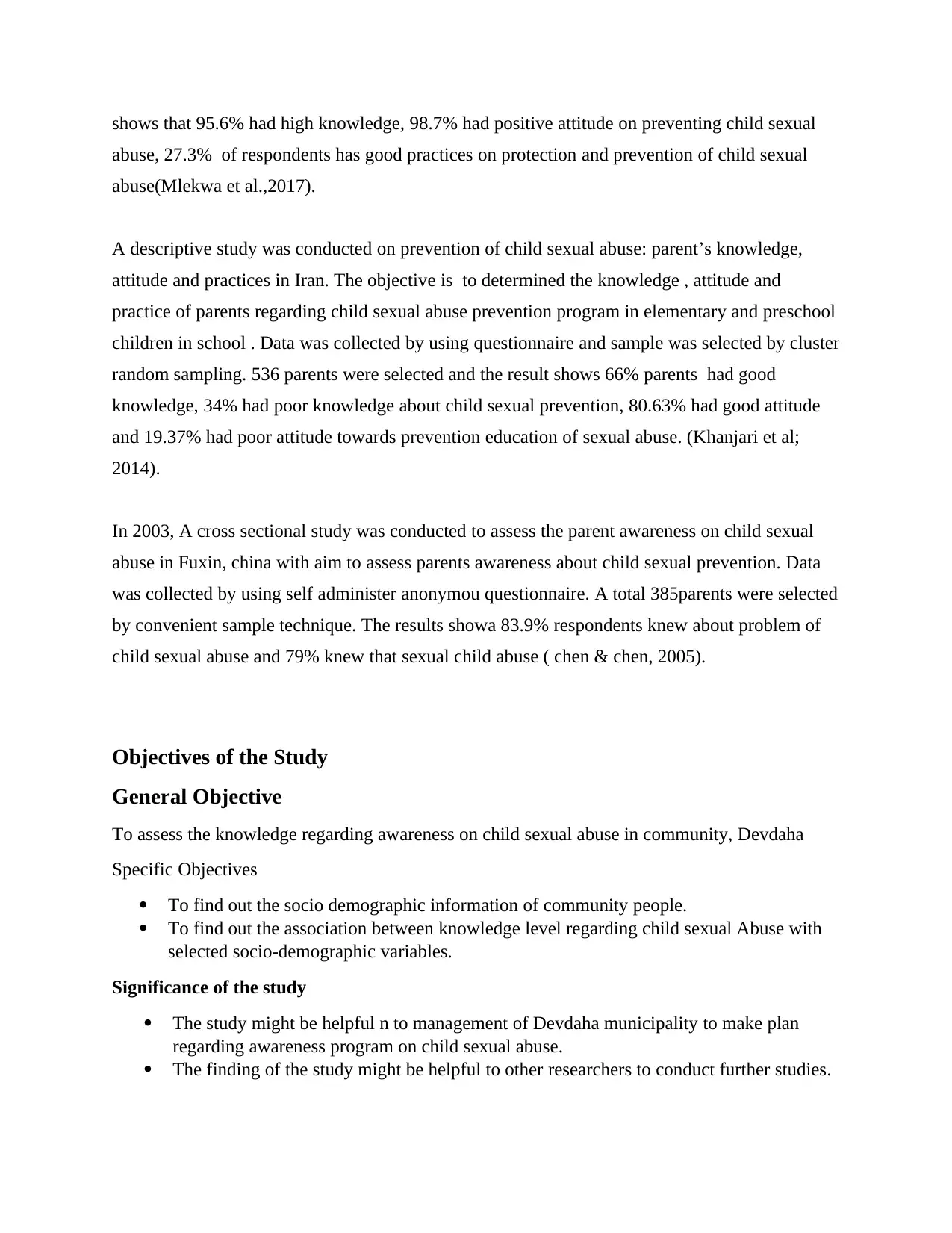
shows that 95.6% had high knowledge, 98.7% had positive attitude on preventing child sexual
abuse, 27.3% of respondents has good practices on protection and prevention of child sexual
abuse(Mlekwa et al.,2017).
A descriptive study was conducted on prevention of child sexual abuse: parent’s knowledge,
attitude and practices in Iran. The objective is to determined the knowledge , attitude and
practice of parents regarding child sexual abuse prevention program in elementary and preschool
children in school . Data was collected by using questionnaire and sample was selected by cluster
random sampling. 536 parents were selected and the result shows 66% parents had good
knowledge, 34% had poor knowledge about child sexual prevention, 80.63% had good attitude
and 19.37% had poor attitude towards prevention education of sexual abuse. (Khanjari et al;
2014).
In 2003, A cross sectional study was conducted to assess the parent awareness on child sexual
abuse in Fuxin, china with aim to assess parents awareness about child sexual prevention. Data
was collected by using self administer anonymou questionnaire. A total 385parents were selected
by convenient sample technique. The results showa 83.9% respondents knew about problem of
child sexual abuse and 79% knew that sexual child abuse ( chen & chen, 2005).
Objectives of the Study
General Objective
To assess the knowledge regarding awareness on child sexual abuse in community, Devdaha
Specific Objectives
To find out the socio demographic information of community people.
To find out the association between knowledge level regarding child sexual Abuse with
selected socio-demographic variables.
Significance of the study
The study might be helpful n to management of Devdaha municipality to make plan
regarding awareness program on child sexual abuse.
The finding of the study might be helpful to other researchers to conduct further studies.
abuse, 27.3% of respondents has good practices on protection and prevention of child sexual
abuse(Mlekwa et al.,2017).
A descriptive study was conducted on prevention of child sexual abuse: parent’s knowledge,
attitude and practices in Iran. The objective is to determined the knowledge , attitude and
practice of parents regarding child sexual abuse prevention program in elementary and preschool
children in school . Data was collected by using questionnaire and sample was selected by cluster
random sampling. 536 parents were selected and the result shows 66% parents had good
knowledge, 34% had poor knowledge about child sexual prevention, 80.63% had good attitude
and 19.37% had poor attitude towards prevention education of sexual abuse. (Khanjari et al;
2014).
In 2003, A cross sectional study was conducted to assess the parent awareness on child sexual
abuse in Fuxin, china with aim to assess parents awareness about child sexual prevention. Data
was collected by using self administer anonymou questionnaire. A total 385parents were selected
by convenient sample technique. The results showa 83.9% respondents knew about problem of
child sexual abuse and 79% knew that sexual child abuse ( chen & chen, 2005).
Objectives of the Study
General Objective
To assess the knowledge regarding awareness on child sexual abuse in community, Devdaha
Specific Objectives
To find out the socio demographic information of community people.
To find out the association between knowledge level regarding child sexual Abuse with
selected socio-demographic variables.
Significance of the study
The study might be helpful n to management of Devdaha municipality to make plan
regarding awareness program on child sexual abuse.
The finding of the study might be helpful to other researchers to conduct further studies.

Conceptual framework
Conceptual framework refers to interrelated concepts or abstraction that is assembled
together in some rational scheme by virtue of their relevance to common theme. Theoretical
and conceptual framework provides an important content for scientific investigation.
Fig: Conceptual framework on Awareness regarding child sexual abuse among parents
children.
Research Question
What is the level of knowledge regarding awareness of parents regarding child sexual abuse ?
Research variable
Parent’s awareness regarding child sexual abuse
Dependent variables
Prevalence of child sexual abuse.
Demographic variables
Age
Family type
Marital status
Education level
Personal Experience
Prevention of Child
Sexual Abuse
Mass media
Age Gender
Education
Status Occupation
Awareness
regarding Child
Sexual Abuse
Family type
Conceptual framework refers to interrelated concepts or abstraction that is assembled
together in some rational scheme by virtue of their relevance to common theme. Theoretical
and conceptual framework provides an important content for scientific investigation.
Fig: Conceptual framework on Awareness regarding child sexual abuse among parents
children.
Research Question
What is the level of knowledge regarding awareness of parents regarding child sexual abuse ?
Research variable
Parent’s awareness regarding child sexual abuse
Dependent variables
Prevalence of child sexual abuse.
Demographic variables
Age
Family type
Marital status
Education level
Personal Experience
Prevention of Child
Sexual Abuse
Mass media
Age Gender
Education
Status Occupation
Awareness
regarding Child
Sexual Abuse
Family type
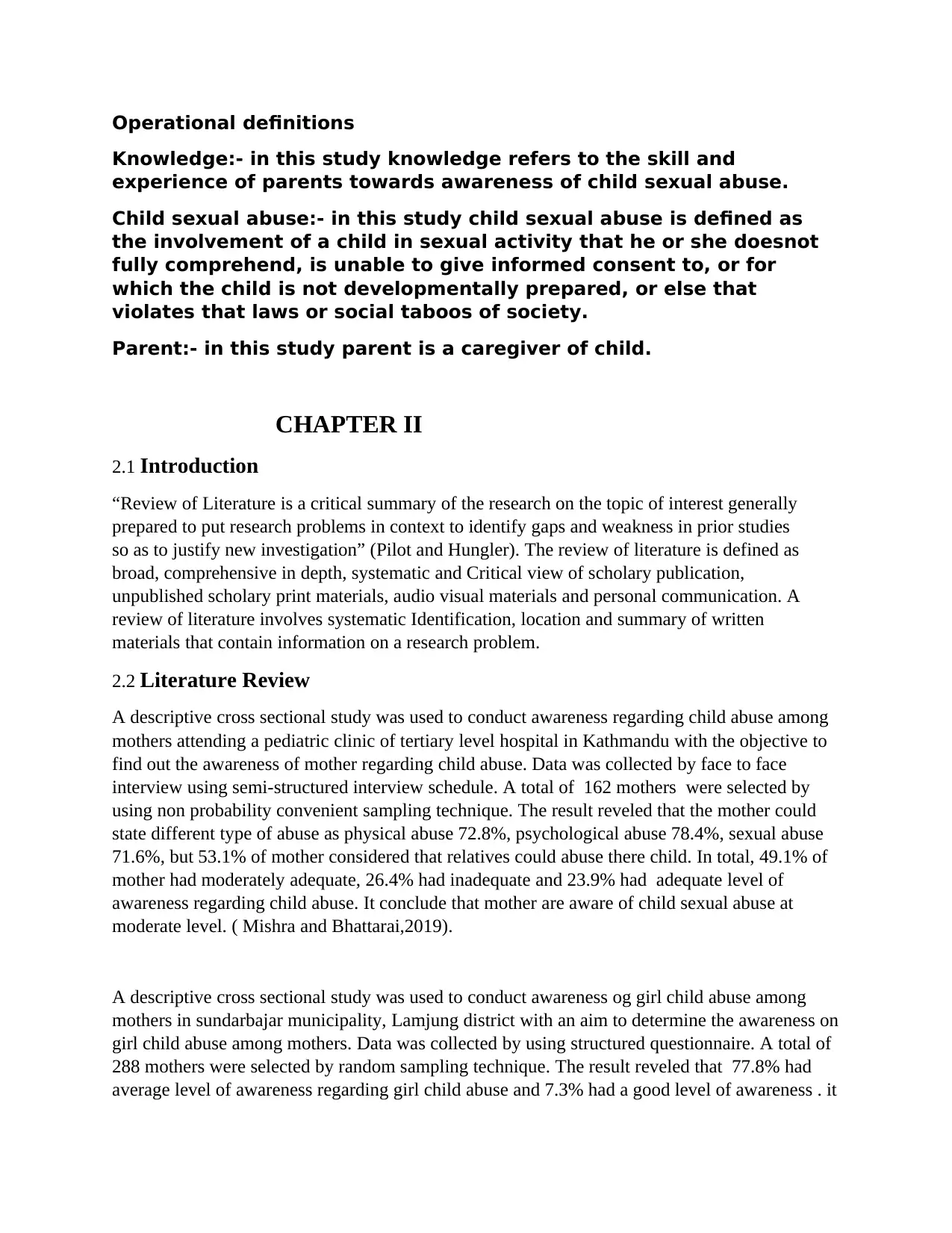
Operational definitions
Knowledge:- in this study knowledge refers to the skill and
experience of parents towards awareness of child sexual abuse.
Child sexual abuse:- in this study child sexual abuse is defined as
the involvement of a child in sexual activity that he or she doesnot
fully comprehend, is unable to give informed consent to, or for
which the child is not developmentally prepared, or else that
violates that laws or social taboos of society.
Parent:- in this study parent is a caregiver of child.
CHAPTER II
2.1 Introduction
“Review of Literature is a critical summary of the research on the topic of interest generally
prepared to put research problems in context to identify gaps and weakness in prior studies
so as to justify new investigation” (Pilot and Hungler). The review of literature is defined as
broad, comprehensive in depth, systematic and Critical view of scholary publication,
unpublished scholary print materials, audio visual materials and personal communication. A
review of literature involves systematic Identification, location and summary of written
materials that contain information on a research problem.
2.2 Literature Review
A descriptive cross sectional study was used to conduct awareness regarding child abuse among
mothers attending a pediatric clinic of tertiary level hospital in Kathmandu with the objective to
find out the awareness of mother regarding child abuse. Data was collected by face to face
interview using semi-structured interview schedule. A total of 162 mothers were selected by
using non probability convenient sampling technique. The result reveled that the mother could
state different type of abuse as physical abuse 72.8%, psychological abuse 78.4%, sexual abuse
71.6%, but 53.1% of mother considered that relatives could abuse there child. In total, 49.1% of
mother had moderately adequate, 26.4% had inadequate and 23.9% had adequate level of
awareness regarding child abuse. It conclude that mother are aware of child sexual abuse at
moderate level. ( Mishra and Bhattarai,2019).
A descriptive cross sectional study was used to conduct awareness og girl child abuse among
mothers in sundarbajar municipality, Lamjung district with an aim to determine the awareness on
girl child abuse among mothers. Data was collected by using structured questionnaire. A total of
288 mothers were selected by random sampling technique. The result reveled that 77.8% had
average level of awareness regarding girl child abuse and 7.3% had a good level of awareness . it
Knowledge:- in this study knowledge refers to the skill and
experience of parents towards awareness of child sexual abuse.
Child sexual abuse:- in this study child sexual abuse is defined as
the involvement of a child in sexual activity that he or she doesnot
fully comprehend, is unable to give informed consent to, or for
which the child is not developmentally prepared, or else that
violates that laws or social taboos of society.
Parent:- in this study parent is a caregiver of child.
CHAPTER II
2.1 Introduction
“Review of Literature is a critical summary of the research on the topic of interest generally
prepared to put research problems in context to identify gaps and weakness in prior studies
so as to justify new investigation” (Pilot and Hungler). The review of literature is defined as
broad, comprehensive in depth, systematic and Critical view of scholary publication,
unpublished scholary print materials, audio visual materials and personal communication. A
review of literature involves systematic Identification, location and summary of written
materials that contain information on a research problem.
2.2 Literature Review
A descriptive cross sectional study was used to conduct awareness regarding child abuse among
mothers attending a pediatric clinic of tertiary level hospital in Kathmandu with the objective to
find out the awareness of mother regarding child abuse. Data was collected by face to face
interview using semi-structured interview schedule. A total of 162 mothers were selected by
using non probability convenient sampling technique. The result reveled that the mother could
state different type of abuse as physical abuse 72.8%, psychological abuse 78.4%, sexual abuse
71.6%, but 53.1% of mother considered that relatives could abuse there child. In total, 49.1% of
mother had moderately adequate, 26.4% had inadequate and 23.9% had adequate level of
awareness regarding child abuse. It conclude that mother are aware of child sexual abuse at
moderate level. ( Mishra and Bhattarai,2019).
A descriptive cross sectional study was used to conduct awareness og girl child abuse among
mothers in sundarbajar municipality, Lamjung district with an aim to determine the awareness on
girl child abuse among mothers. Data was collected by using structured questionnaire. A total of
288 mothers were selected by random sampling technique. The result reveled that 77.8% had
average level of awareness regarding girl child abuse and 7.3% had a good level of awareness . it
Secure Best Marks with AI Grader
Need help grading? Try our AI Grader for instant feedback on your assignments.
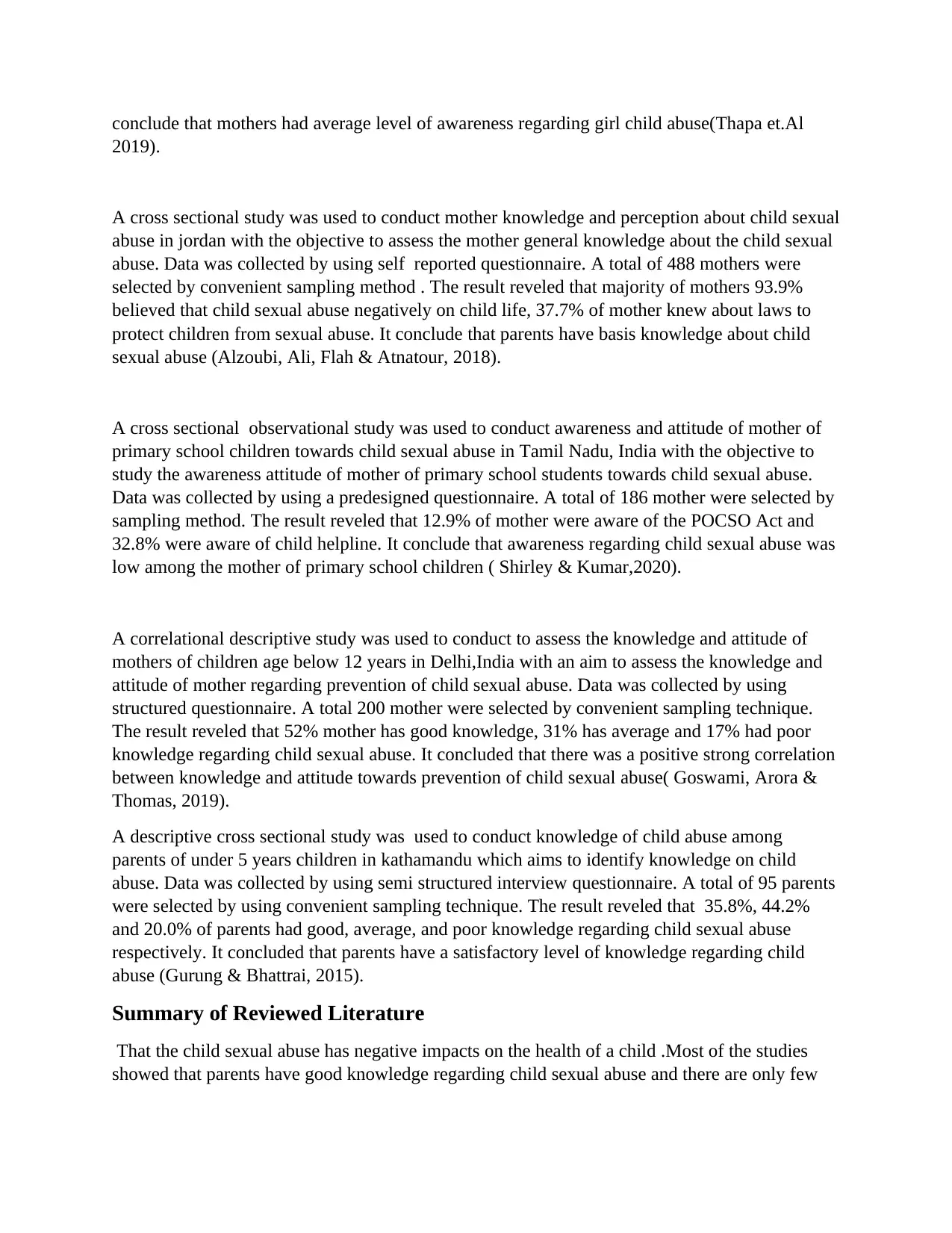
conclude that mothers had average level of awareness regarding girl child abuse(Thapa et.Al
2019).
A cross sectional study was used to conduct mother knowledge and perception about child sexual
abuse in jordan with the objective to assess the mother general knowledge about the child sexual
abuse. Data was collected by using self reported questionnaire. A total of 488 mothers were
selected by convenient sampling method . The result reveled that majority of mothers 93.9%
believed that child sexual abuse negatively on child life, 37.7% of mother knew about laws to
protect children from sexual abuse. It conclude that parents have basis knowledge about child
sexual abuse (Alzoubi, Ali, Flah & Atnatour, 2018).
A cross sectional observational study was used to conduct awareness and attitude of mother of
primary school children towards child sexual abuse in Tamil Nadu, India with the objective to
study the awareness attitude of mother of primary school students towards child sexual abuse.
Data was collected by using a predesigned questionnaire. A total of 186 mother were selected by
sampling method. The result reveled that 12.9% of mother were aware of the POCSO Act and
32.8% were aware of child helpline. It conclude that awareness regarding child sexual abuse was
low among the mother of primary school children ( Shirley & Kumar,2020).
A correlational descriptive study was used to conduct to assess the knowledge and attitude of
mothers of children age below 12 years in Delhi,India with an aim to assess the knowledge and
attitude of mother regarding prevention of child sexual abuse. Data was collected by using
structured questionnaire. A total 200 mother were selected by convenient sampling technique.
The result reveled that 52% mother has good knowledge, 31% has average and 17% had poor
knowledge regarding child sexual abuse. It concluded that there was a positive strong correlation
between knowledge and attitude towards prevention of child sexual abuse( Goswami, Arora &
Thomas, 2019).
A descriptive cross sectional study was used to conduct knowledge of child abuse among
parents of under 5 years children in kathamandu which aims to identify knowledge on child
abuse. Data was collected by using semi structured interview questionnaire. A total of 95 parents
were selected by using convenient sampling technique. The result reveled that 35.8%, 44.2%
and 20.0% of parents had good, average, and poor knowledge regarding child sexual abuse
respectively. It concluded that parents have a satisfactory level of knowledge regarding child
abuse (Gurung & Bhattrai, 2015).
Summary of Reviewed Literature
That the child sexual abuse has negative impacts on the health of a child .Most of the studies
showed that parents have good knowledge regarding child sexual abuse and there are only few
2019).
A cross sectional study was used to conduct mother knowledge and perception about child sexual
abuse in jordan with the objective to assess the mother general knowledge about the child sexual
abuse. Data was collected by using self reported questionnaire. A total of 488 mothers were
selected by convenient sampling method . The result reveled that majority of mothers 93.9%
believed that child sexual abuse negatively on child life, 37.7% of mother knew about laws to
protect children from sexual abuse. It conclude that parents have basis knowledge about child
sexual abuse (Alzoubi, Ali, Flah & Atnatour, 2018).
A cross sectional observational study was used to conduct awareness and attitude of mother of
primary school children towards child sexual abuse in Tamil Nadu, India with the objective to
study the awareness attitude of mother of primary school students towards child sexual abuse.
Data was collected by using a predesigned questionnaire. A total of 186 mother were selected by
sampling method. The result reveled that 12.9% of mother were aware of the POCSO Act and
32.8% were aware of child helpline. It conclude that awareness regarding child sexual abuse was
low among the mother of primary school children ( Shirley & Kumar,2020).
A correlational descriptive study was used to conduct to assess the knowledge and attitude of
mothers of children age below 12 years in Delhi,India with an aim to assess the knowledge and
attitude of mother regarding prevention of child sexual abuse. Data was collected by using
structured questionnaire. A total 200 mother were selected by convenient sampling technique.
The result reveled that 52% mother has good knowledge, 31% has average and 17% had poor
knowledge regarding child sexual abuse. It concluded that there was a positive strong correlation
between knowledge and attitude towards prevention of child sexual abuse( Goswami, Arora &
Thomas, 2019).
A descriptive cross sectional study was used to conduct knowledge of child abuse among
parents of under 5 years children in kathamandu which aims to identify knowledge on child
abuse. Data was collected by using semi structured interview questionnaire. A total of 95 parents
were selected by using convenient sampling technique. The result reveled that 35.8%, 44.2%
and 20.0% of parents had good, average, and poor knowledge regarding child sexual abuse
respectively. It concluded that parents have a satisfactory level of knowledge regarding child
abuse (Gurung & Bhattrai, 2015).
Summary of Reviewed Literature
That the child sexual abuse has negative impacts on the health of a child .Most of the studies
showed that parents have good knowledge regarding child sexual abuse and there are only few

studies in Nepal. So, researcher is interested to conduct this study to find out the awareness
regarding child sexual abuse among parents.
CHAPTER III
RESEARCH METHODOLOGY
Research design
The descriptive, cross-sectional research design will be used to find out awareness of child
sexual abuse among the parents of Devdaha municipality.
Study setting and population
This study will be carried out in Devdaha municipality ward no 4, Singaha tole Rupandehi
district, Lumbini province.
Study populations will be parents of school going children of Singaha.
Sample size
The sample size will be 60.
Sampling technique
In this study, non- probability sampling technique will be used to select the samples of parents
from Devdaha community.
Selection criteria
Inclusion criteria
Willing to participate in the study.
Available during the time of data collection
Exclusion criteria
Participants who are ill at the time of data collection.
Participants who are absent at the time of data collection.
Research instrumentation
Part I: Socio- Demographic data
Part II: knowledge basis questionaire regarding child sexual abuse.
Validity and Reliability
Validity
For the socio demographic data, Content validity was established on the basis of the literature
review by a consulting research advisor.
regarding child sexual abuse among parents.
CHAPTER III
RESEARCH METHODOLOGY
Research design
The descriptive, cross-sectional research design will be used to find out awareness of child
sexual abuse among the parents of Devdaha municipality.
Study setting and population
This study will be carried out in Devdaha municipality ward no 4, Singaha tole Rupandehi
district, Lumbini province.
Study populations will be parents of school going children of Singaha.
Sample size
The sample size will be 60.
Sampling technique
In this study, non- probability sampling technique will be used to select the samples of parents
from Devdaha community.
Selection criteria
Inclusion criteria
Willing to participate in the study.
Available during the time of data collection
Exclusion criteria
Participants who are ill at the time of data collection.
Participants who are absent at the time of data collection.
Research instrumentation
Part I: Socio- Demographic data
Part II: knowledge basis questionaire regarding child sexual abuse.
Validity and Reliability
Validity
For the socio demographic data, Content validity was established on the basis of the literature
review by a consulting research advisor.
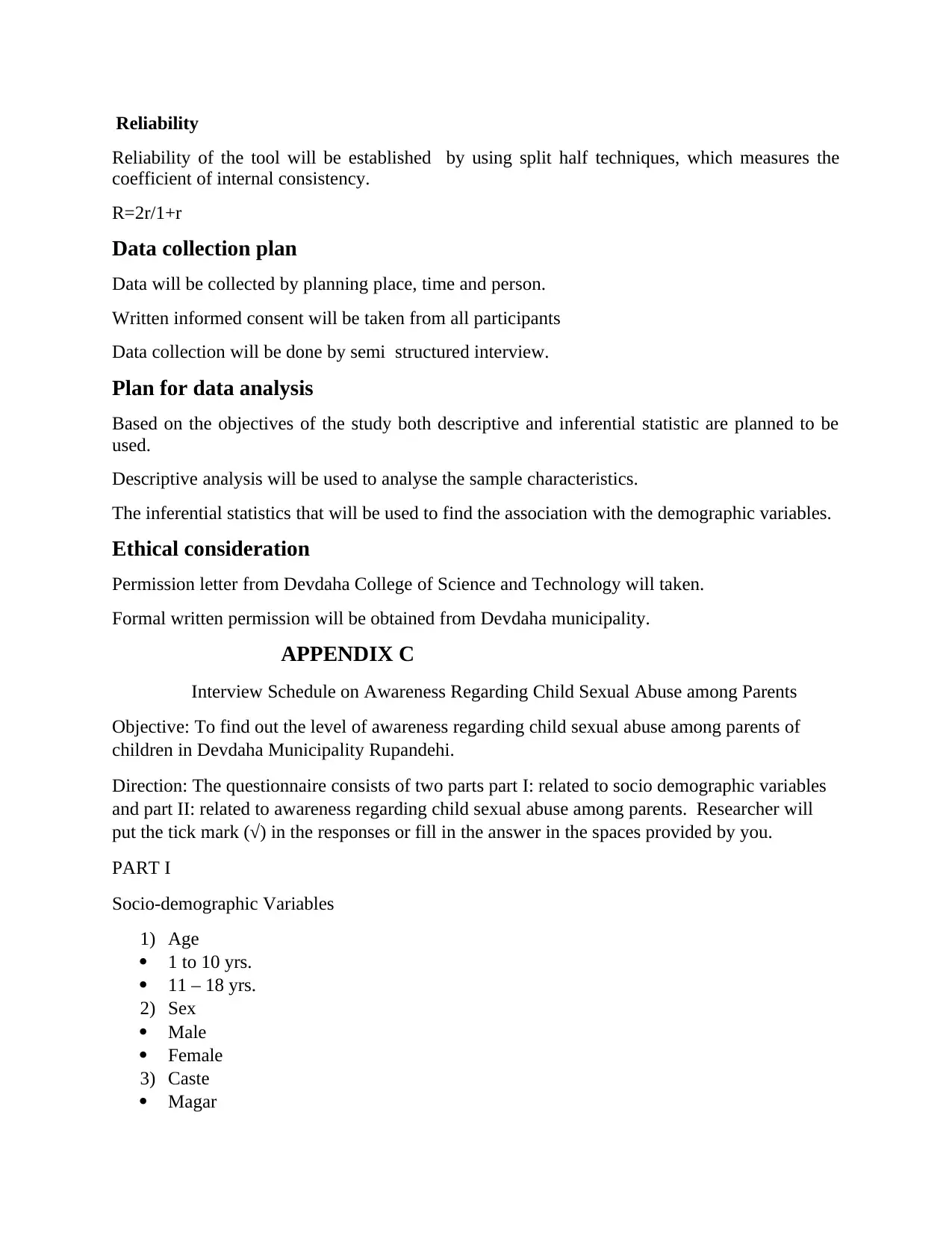
Reliability
Reliability of the tool will be established by using split half techniques, which measures the
coefficient of internal consistency.
R=2r/1+r
Data collection plan
Data will be collected by planning place, time and person.
Written informed consent will be taken from all participants
Data collection will be done by semi structured interview.
Plan for data analysis
Based on the objectives of the study both descriptive and inferential statistic are planned to be
used.
Descriptive analysis will be used to analyse the sample characteristics.
The inferential statistics that will be used to find the association with the demographic variables.
Ethical consideration
Permission letter from Devdaha College of Science and Technology will taken.
Formal written permission will be obtained from Devdaha municipality.
APPENDIX C
Interview Schedule on Awareness Regarding Child Sexual Abuse among Parents
Objective: To find out the level of awareness regarding child sexual abuse among parents of
children in Devdaha Municipality Rupandehi.
Direction: The questionnaire consists of two parts part I: related to socio demographic variables
and part II: related to awareness regarding child sexual abuse among parents. Researcher will
put the tick mark (√) in the responses or fill in the answer in the spaces provided by you.
PART I
Socio-demographic Variables
1) Age
1 to 10 yrs.
11 – 18 yrs.
2) Sex
Male
Female
3) Caste
Magar
Reliability of the tool will be established by using split half techniques, which measures the
coefficient of internal consistency.
R=2r/1+r
Data collection plan
Data will be collected by planning place, time and person.
Written informed consent will be taken from all participants
Data collection will be done by semi structured interview.
Plan for data analysis
Based on the objectives of the study both descriptive and inferential statistic are planned to be
used.
Descriptive analysis will be used to analyse the sample characteristics.
The inferential statistics that will be used to find the association with the demographic variables.
Ethical consideration
Permission letter from Devdaha College of Science and Technology will taken.
Formal written permission will be obtained from Devdaha municipality.
APPENDIX C
Interview Schedule on Awareness Regarding Child Sexual Abuse among Parents
Objective: To find out the level of awareness regarding child sexual abuse among parents of
children in Devdaha Municipality Rupandehi.
Direction: The questionnaire consists of two parts part I: related to socio demographic variables
and part II: related to awareness regarding child sexual abuse among parents. Researcher will
put the tick mark (√) in the responses or fill in the answer in the spaces provided by you.
PART I
Socio-demographic Variables
1) Age
1 to 10 yrs.
11 – 18 yrs.
2) Sex
Male
Female
3) Caste
Magar
Paraphrase This Document
Need a fresh take? Get an instant paraphrase of this document with our AI Paraphraser
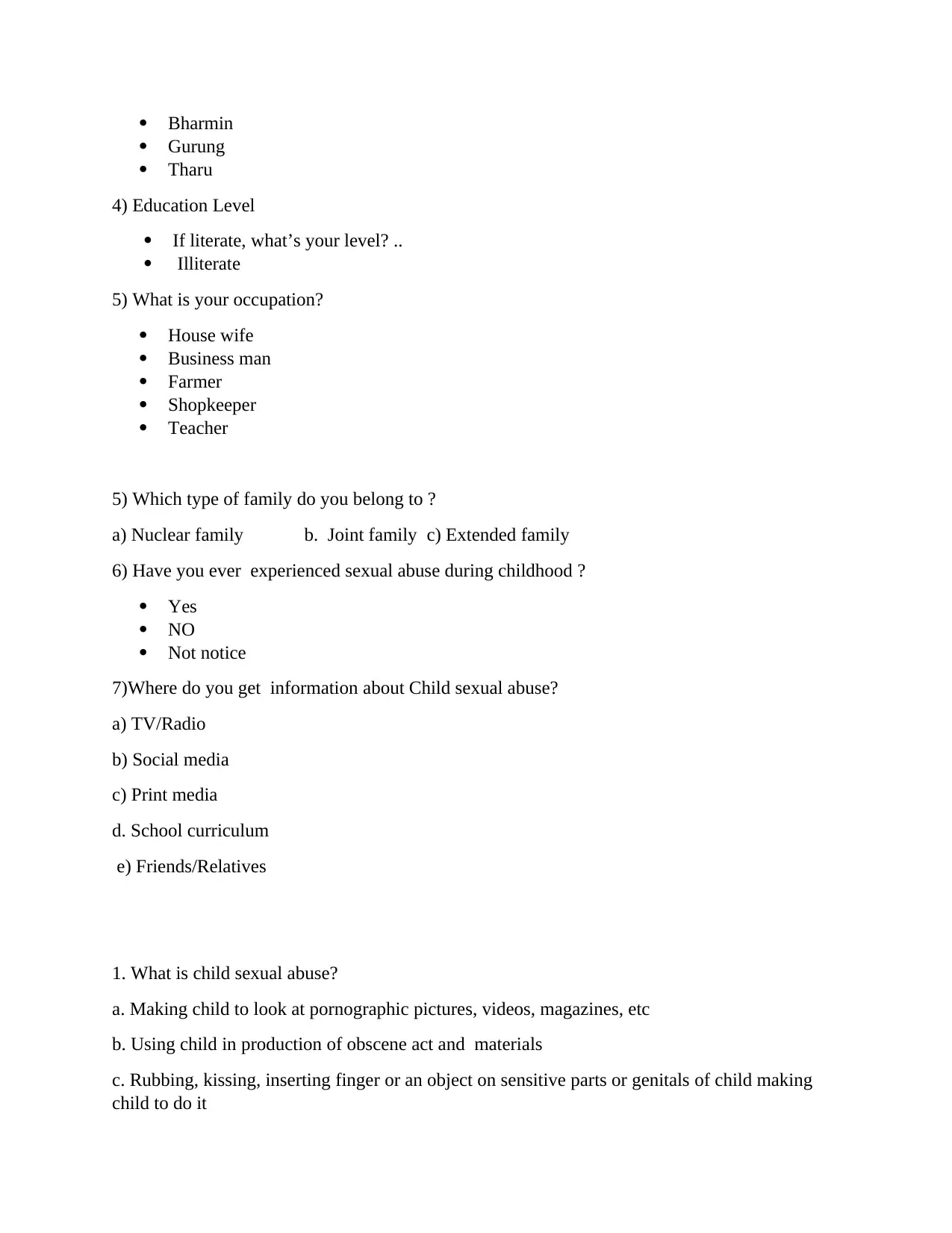
Bharmin
Gurung
Tharu
4) Education Level
If literate, what’s your level? ..
Illiterate
5) What is your occupation?
House wife
Business man
Farmer
Shopkeeper
Teacher
5) Which type of family do you belong to ?
a) Nuclear family b. Joint family c) Extended family
6) Have you ever experienced sexual abuse during childhood ?
Yes
NO
Not notice
7)Where do you get information about Child sexual abuse?
a) TV/Radio
b) Social media
c) Print media
d. School curriculum
e) Friends/Relatives
1. What is child sexual abuse?
a. Making child to look at pornographic pictures, videos, magazines, etc
b. Using child in production of obscene act and materials
c. Rubbing, kissing, inserting finger or an object on sensitive parts or genitals of child making
child to do it
Gurung
Tharu
4) Education Level
If literate, what’s your level? ..
Illiterate
5) What is your occupation?
House wife
Business man
Farmer
Shopkeeper
Teacher
5) Which type of family do you belong to ?
a) Nuclear family b. Joint family c) Extended family
6) Have you ever experienced sexual abuse during childhood ?
Yes
NO
Not notice
7)Where do you get information about Child sexual abuse?
a) TV/Radio
b) Social media
c) Print media
d. School curriculum
e) Friends/Relatives
1. What is child sexual abuse?
a. Making child to look at pornographic pictures, videos, magazines, etc
b. Using child in production of obscene act and materials
c. Rubbing, kissing, inserting finger or an object on sensitive parts or genitals of child making
child to do it
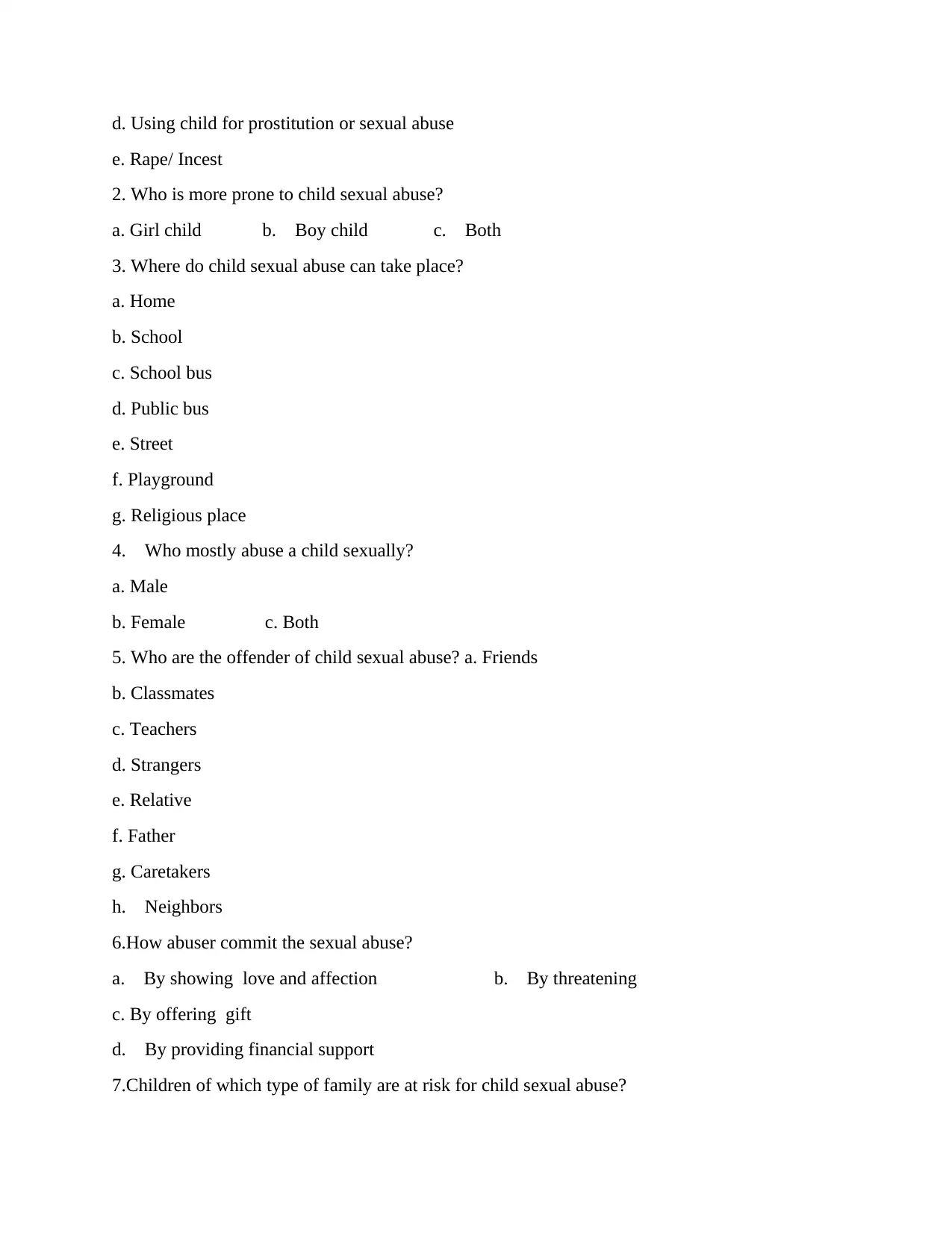
d. Using child for prostitution or sexual abuse
e. Rape/ Incest
2. Who is more prone to child sexual abuse?
a. Girl child b. Boy child c. Both
3. Where do child sexual abuse can take place?
a. Home
b. School
c. School bus
d. Public bus
e. Street
f. Playground
g. Religious place
4. Who mostly abuse a child sexually?
a. Male
b. Female c. Both
5. Who are the offender of child sexual abuse? a. Friends
b. Classmates
c. Teachers
d. Strangers
e. Relative
f. Father
g. Caretakers
h. Neighbors
6.How abuser commit the sexual abuse?
a. By showing love and affection b. By threatening
c. By offering gift
d. By providing financial support
7.Children of which type of family are at risk for child sexual abuse?
e. Rape/ Incest
2. Who is more prone to child sexual abuse?
a. Girl child b. Boy child c. Both
3. Where do child sexual abuse can take place?
a. Home
b. School
c. School bus
d. Public bus
e. Street
f. Playground
g. Religious place
4. Who mostly abuse a child sexually?
a. Male
b. Female c. Both
5. Who are the offender of child sexual abuse? a. Friends
b. Classmates
c. Teachers
d. Strangers
e. Relative
f. Father
g. Caretakers
h. Neighbors
6.How abuser commit the sexual abuse?
a. By showing love and affection b. By threatening
c. By offering gift
d. By providing financial support
7.Children of which type of family are at risk for child sexual abuse?

a. Both parents employed
b. Broken home
c. Alcoholic or drug abusing parents
d. Single parents
e. Parents with mental disability f. Poor family
8.Which type of children are at risk of being sexually abused
?
a. Shy and less communicative child
b. Adopted child
c. Low self-esteem
d. No sex education
e. Children with physical disability
f. Children with mental disability
9.What are the immediate physical sign present on child of sexual abuse?
a. Scratches
b. Bruises on different body parts
c. Difficulty in walking or sitting
d. Torn or bloody clothes
e. Restlessness
f. Injuries
g. Bleeding from genital or genital injury
h. Pelvic fractures
i. Painful urination
10.
What are the long term physical problems present on sexually abused child?
a. Gastrointestinal problems
b. STIs/HIV/AIDs
c. Infertility
b. Broken home
c. Alcoholic or drug abusing parents
d. Single parents
e. Parents with mental disability f. Poor family
8.Which type of children are at risk of being sexually abused
?
a. Shy and less communicative child
b. Adopted child
c. Low self-esteem
d. No sex education
e. Children with physical disability
f. Children with mental disability
9.What are the immediate physical sign present on child of sexual abuse?
a. Scratches
b. Bruises on different body parts
c. Difficulty in walking or sitting
d. Torn or bloody clothes
e. Restlessness
f. Injuries
g. Bleeding from genital or genital injury
h. Pelvic fractures
i. Painful urination
10.
What are the long term physical problems present on sexually abused child?
a. Gastrointestinal problems
b. STIs/HIV/AIDs
c. Infertility
Secure Best Marks with AI Grader
Need help grading? Try our AI Grader for instant feedback on your assignments.
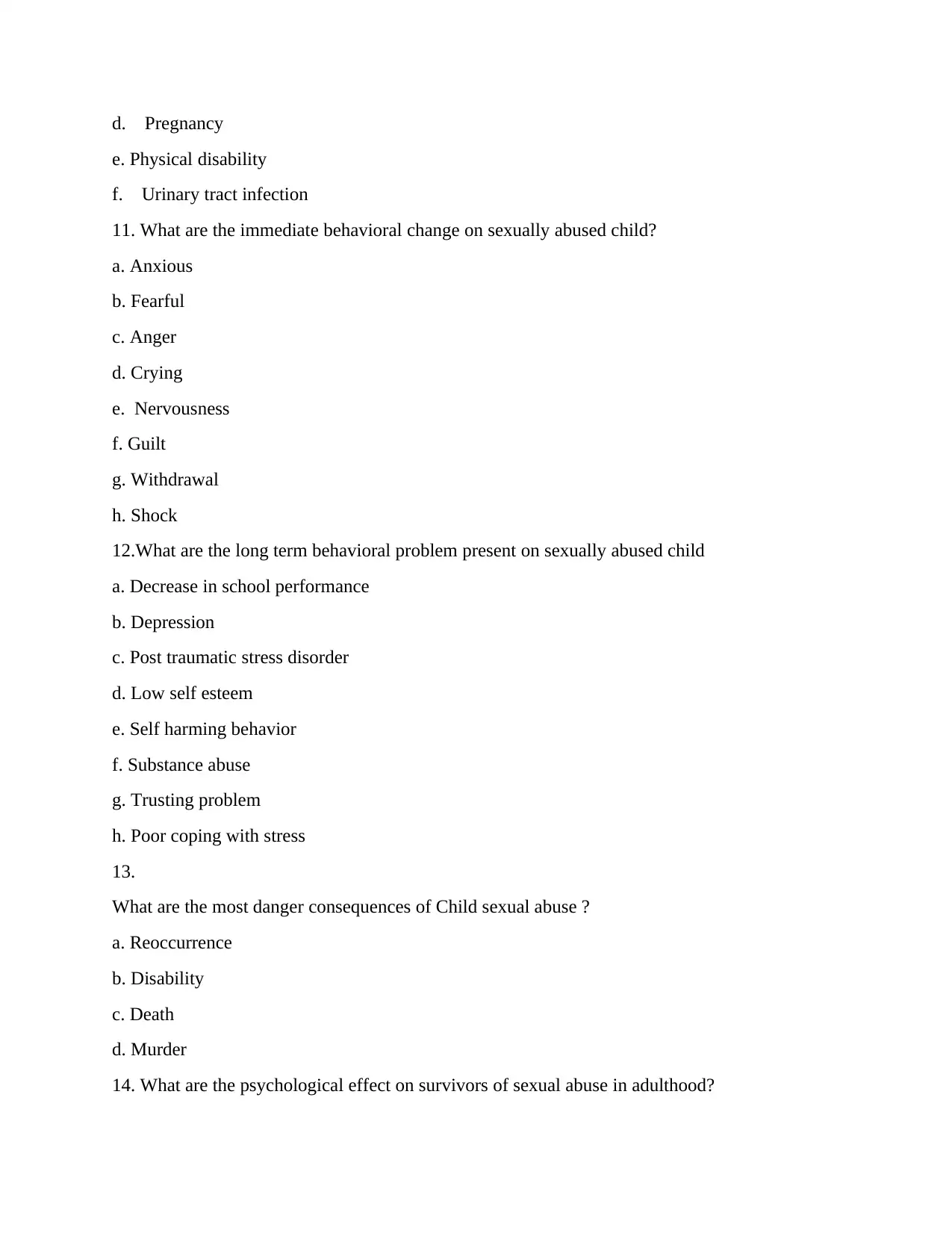
d. Pregnancy
e. Physical disability
f. Urinary tract infection
11. What are the immediate behavioral change on sexually abused child?
a. Anxious
b. Fearful
c. Anger
d. Crying
e. Nervousness
f. Guilt
g. Withdrawal
h. Shock
12.What are the long term behavioral problem present on sexually abused child
a. Decrease in school performance
b. Depression
c. Post traumatic stress disorder
d. Low self esteem
e. Self harming behavior
f. Substance abuse
g. Trusting problem
h. Poor coping with stress
13.
What are the most danger consequences of Child sexual abuse ?
a. Reoccurrence
b. Disability
c. Death
d. Murder
14. What are the psychological effect on survivors of sexual abuse in adulthood?
e. Physical disability
f. Urinary tract infection
11. What are the immediate behavioral change on sexually abused child?
a. Anxious
b. Fearful
c. Anger
d. Crying
e. Nervousness
f. Guilt
g. Withdrawal
h. Shock
12.What are the long term behavioral problem present on sexually abused child
a. Decrease in school performance
b. Depression
c. Post traumatic stress disorder
d. Low self esteem
e. Self harming behavior
f. Substance abuse
g. Trusting problem
h. Poor coping with stress
13.
What are the most danger consequences of Child sexual abuse ?
a. Reoccurrence
b. Disability
c. Death
d. Murder
14. What are the psychological effect on survivors of sexual abuse in adulthood?
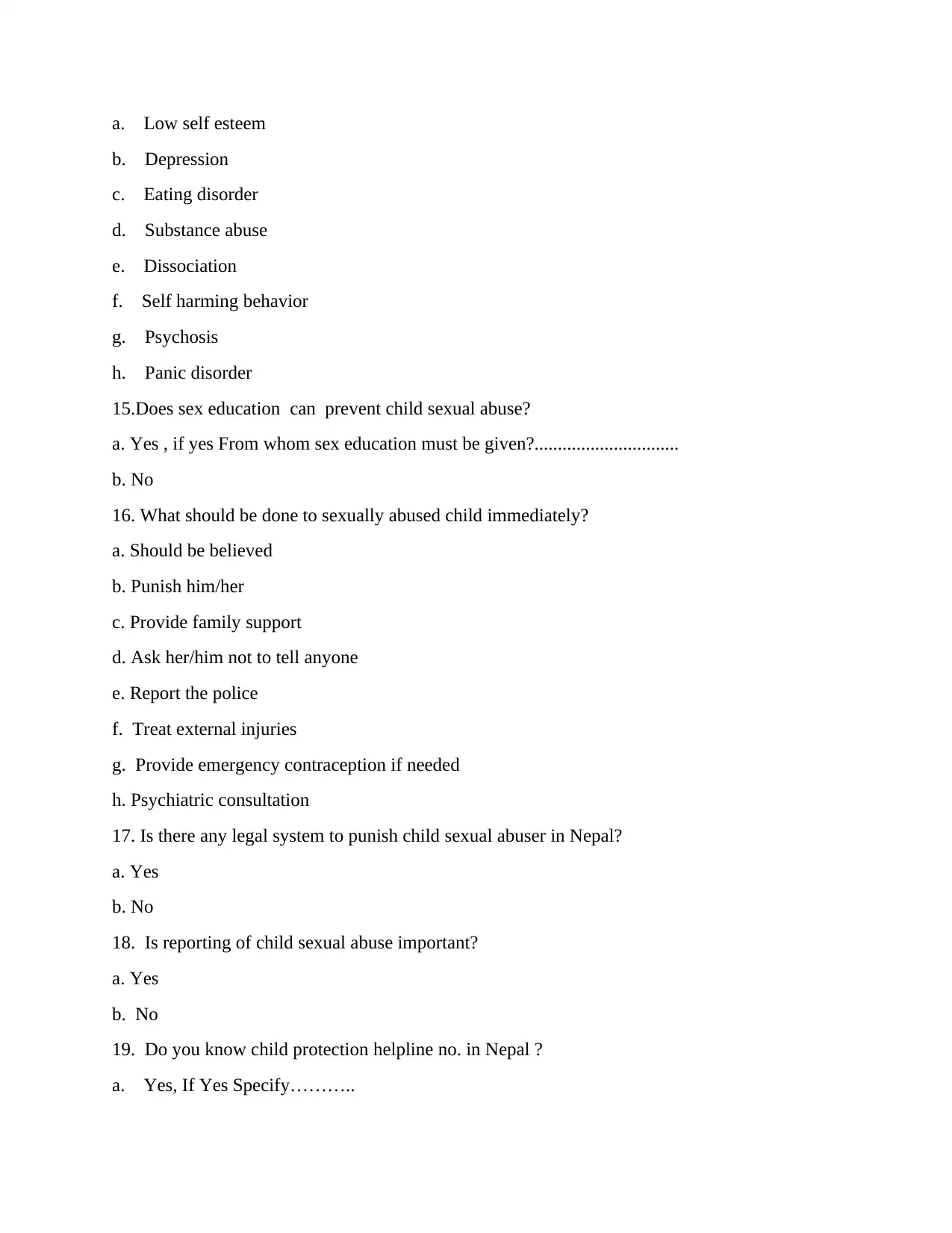
a. Low self esteem
b. Depression
c. Eating disorder
d. Substance abuse
e. Dissociation
f. Self harming behavior
g. Psychosis
h. Panic disorder
15.Does sex education can prevent child sexual abuse?
a. Yes , if yes From whom sex education must be given?...............................
b. No
16. What should be done to sexually abused child immediately?
a. Should be believed
b. Punish him/her
c. Provide family support
d. Ask her/him not to tell anyone
e. Report the police
f. Treat external injuries
g. Provide emergency contraception if needed
h. Psychiatric consultation
17. Is there any legal system to punish child sexual abuser in Nepal?
a. Yes
b. No
18. Is reporting of child sexual abuse important?
a. Yes
b. No
19. Do you know child protection helpline no. in Nepal ?
a. Yes, If Yes Specify………..
b. Depression
c. Eating disorder
d. Substance abuse
e. Dissociation
f. Self harming behavior
g. Psychosis
h. Panic disorder
15.Does sex education can prevent child sexual abuse?
a. Yes , if yes From whom sex education must be given?...............................
b. No
16. What should be done to sexually abused child immediately?
a. Should be believed
b. Punish him/her
c. Provide family support
d. Ask her/him not to tell anyone
e. Report the police
f. Treat external injuries
g. Provide emergency contraception if needed
h. Psychiatric consultation
17. Is there any legal system to punish child sexual abuser in Nepal?
a. Yes
b. No
18. Is reporting of child sexual abuse important?
a. Yes
b. No
19. Do you know child protection helpline no. in Nepal ?
a. Yes, If Yes Specify………..
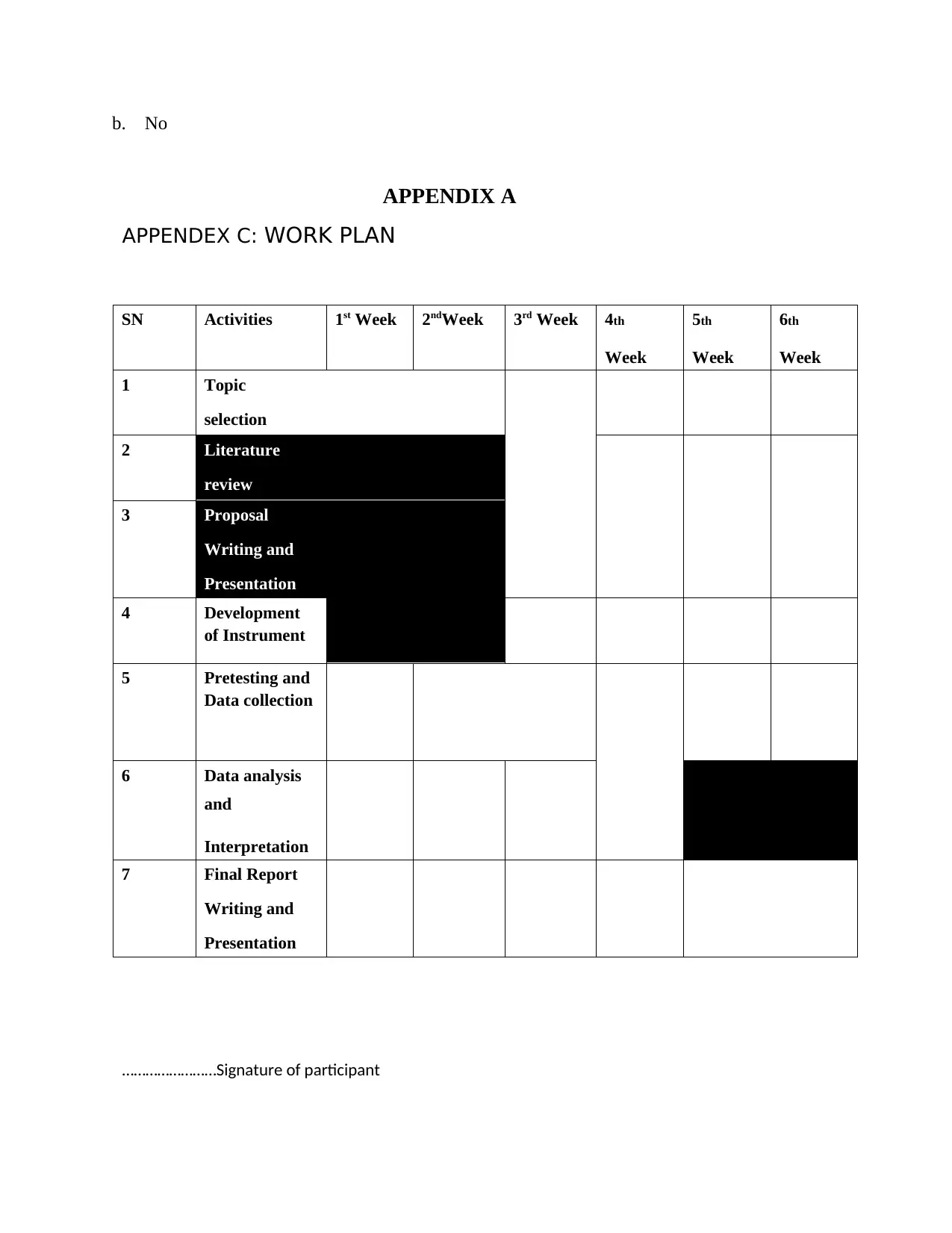
b. No
APPENDIX A
APPENDEX C: WORK PLAN
SN Activities 1st Week 2ndWeek 3rd Week 4th
Week
5th
Week
6th
Week
1 Topic
selection
2 Literature
review
3 Proposal
Writing and
Presentation
4 Development
of Instrument
5 Pretesting and
Data collection
6 Data analysis
and
Interpretation
7 Final Report
Writing and
Presentation
……………………Signature of participant
APPENDIX A
APPENDEX C: WORK PLAN
SN Activities 1st Week 2ndWeek 3rd Week 4th
Week
5th
Week
6th
Week
1 Topic
selection
2 Literature
review
3 Proposal
Writing and
Presentation
4 Development
of Instrument
5 Pretesting and
Data collection
6 Data analysis
and
Interpretation
7 Final Report
Writing and
Presentation
……………………Signature of participant
Paraphrase This Document
Need a fresh take? Get an instant paraphrase of this document with our AI Paraphraser
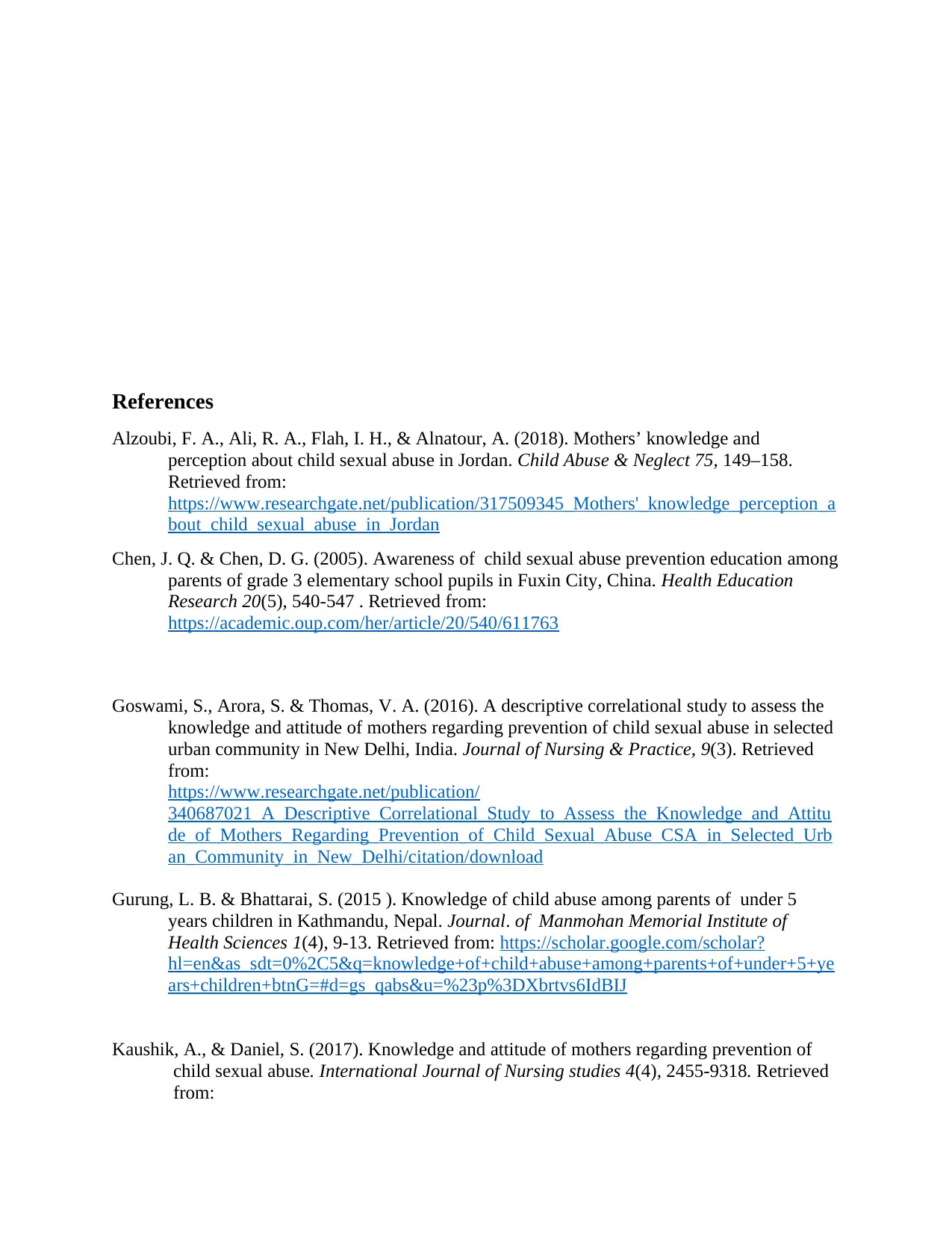
References
Alzoubi, F. A., Ali, R. A., Flah, I. H., & Alnatour, A. (2018). Mothers’ knowledge and
perception about child sexual abuse in Jordan. Child Abuse & Neglect 75, 149–158.
Retrieved from:
https://www.researchgate.net/publication/317509345_Mothers'_knowledge_perception_a
bout_child_sexual_abuse_in_Jordan
Chen, J. Q. & Chen, D. G. (2005). Awareness of child sexual abuse prevention education among
parents of grade 3 elementary school pupils in Fuxin City, China. Health Education
Research 20(5), 540-547 . Retrieved from:
https://academic.oup.com/her/article/20/540/611763
Goswami, S., Arora, S. & Thomas, V. A. (2016). A descriptive correlational study to assess the
knowledge and attitude of mothers regarding prevention of child sexual abuse in selected
urban community in New Delhi, India. Journal of Nursing & Practice, 9(3). Retrieved
from:
https://www.researchgate.net/publication/
340687021_A_Descriptive_Correlational_Study_to_Assess_the_Knowledge_and_Attitu
de_of_Mothers_Regarding_Prevention_of_Child_Sexual_Abuse_CSA_in_Selected_Urb
an_Community_in_New_Delhi/citation/download
Gurung, L. B. & Bhattarai, S. (2015 ). Knowledge of child abuse among parents of under 5
years children in Kathmandu, Nepal. Journal. of Manmohan Memorial Institute of
Health Sciences 1(4), 9-13. Retrieved from: https://scholar.google.com/scholar?
hl=en&as_sdt=0%2C5&q=knowledge+of+child+abuse+among+parents+of+under+5+ye
ars+children+btnG=#d=gs_qabs&u=%23p%3DXbrtvs6IdBIJ
Kaushik, A., & Daniel, S. (2017). Knowledge and attitude of mothers regarding prevention of
child sexual abuse. International Journal of Nursing studies 4(4), 2455-9318. Retrieved
from:
Alzoubi, F. A., Ali, R. A., Flah, I. H., & Alnatour, A. (2018). Mothers’ knowledge and
perception about child sexual abuse in Jordan. Child Abuse & Neglect 75, 149–158.
Retrieved from:
https://www.researchgate.net/publication/317509345_Mothers'_knowledge_perception_a
bout_child_sexual_abuse_in_Jordan
Chen, J. Q. & Chen, D. G. (2005). Awareness of child sexual abuse prevention education among
parents of grade 3 elementary school pupils in Fuxin City, China. Health Education
Research 20(5), 540-547 . Retrieved from:
https://academic.oup.com/her/article/20/540/611763
Goswami, S., Arora, S. & Thomas, V. A. (2016). A descriptive correlational study to assess the
knowledge and attitude of mothers regarding prevention of child sexual abuse in selected
urban community in New Delhi, India. Journal of Nursing & Practice, 9(3). Retrieved
from:
https://www.researchgate.net/publication/
340687021_A_Descriptive_Correlational_Study_to_Assess_the_Knowledge_and_Attitu
de_of_Mothers_Regarding_Prevention_of_Child_Sexual_Abuse_CSA_in_Selected_Urb
an_Community_in_New_Delhi/citation/download
Gurung, L. B. & Bhattarai, S. (2015 ). Knowledge of child abuse among parents of under 5
years children in Kathmandu, Nepal. Journal. of Manmohan Memorial Institute of
Health Sciences 1(4), 9-13. Retrieved from: https://scholar.google.com/scholar?
hl=en&as_sdt=0%2C5&q=knowledge+of+child+abuse+among+parents+of+under+5+ye
ars+children+btnG=#d=gs_qabs&u=%23p%3DXbrtvs6IdBIJ
Kaushik, A., & Daniel, S. (2017). Knowledge and attitude of mothers regarding prevention of
child sexual abuse. International Journal of Nursing studies 4(4), 2455-9318. Retrieved
from:
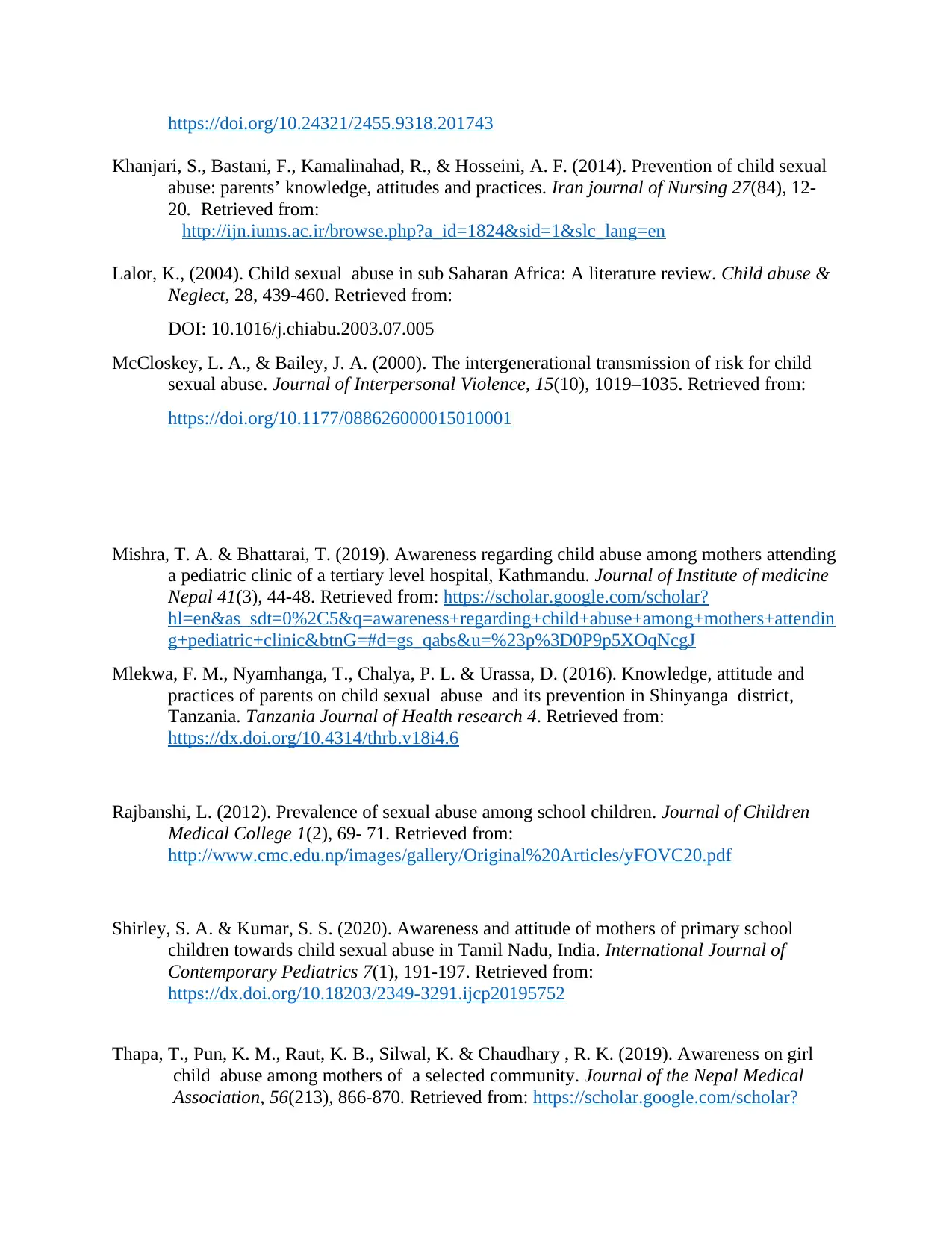
https://doi.org/10.24321/2455.9318.201743
Khanjari, S., Bastani, F., Kamalinahad, R., & Hosseini, A. F. (2014). Prevention of child sexual
abuse: parents’ knowledge, attitudes and practices. Iran journal of Nursing 27(84), 12-
20. Retrieved from:
http://ijn.iums.ac.ir/browse.php?a_id=1824&sid=1&slc_lang=en
Lalor, K., (2004). Child sexual abuse in sub Saharan Africa: A literature review. Child abuse &
Neglect, 28, 439-460. Retrieved from:
DOI: 10.1016/j.chiabu.2003.07.005
McCloskey, L. A., & Bailey, J. A. (2000). The intergenerational transmission of risk for child
sexual abuse. Journal of Interpersonal Violence, 15(10), 1019–1035. Retrieved from:
https://doi.org/10.1177/088626000015010001
Mishra, T. A. & Bhattarai, T. (2019). Awareness regarding child abuse among mothers attending
a pediatric clinic of a tertiary level hospital, Kathmandu. Journal of Institute of medicine
Nepal 41(3), 44-48. Retrieved from: https://scholar.google.com/scholar?
hl=en&as_sdt=0%2C5&q=awareness+regarding+child+abuse+among+mothers+attendin
g+pediatric+clinic&btnG=#d=gs_qabs&u=%23p%3D0P9p5XOqNcgJ
Mlekwa, F. M., Nyamhanga, T., Chalya, P. L. & Urassa, D. (2016). Knowledge, attitude and
practices of parents on child sexual abuse and its prevention in Shinyanga district,
Tanzania. Tanzania Journal of Health research 4. Retrieved from:
https://dx.doi.org/10.4314/thrb.v18i4.6
Rajbanshi, L. (2012). Prevalence of sexual abuse among school children. Journal of Children
Medical College 1(2), 69- 71. Retrieved from:
http://www.cmc.edu.np/images/gallery/Original%20Articles/yFOVC20.pdf
Shirley, S. A. & Kumar, S. S. (2020). Awareness and attitude of mothers of primary school
children towards child sexual abuse in Tamil Nadu, India. International Journal of
Contemporary Pediatrics 7(1), 191-197. Retrieved from:
https://dx.doi.org/10.18203/2349-3291.ijcp20195752
Thapa, T., Pun, K. M., Raut, K. B., Silwal, K. & Chaudhary , R. K. (2019). Awareness on girl
child abuse among mothers of a selected community. Journal of the Nepal Medical
Association, 56(213), 866-870. Retrieved from: https://scholar.google.com/scholar?
Khanjari, S., Bastani, F., Kamalinahad, R., & Hosseini, A. F. (2014). Prevention of child sexual
abuse: parents’ knowledge, attitudes and practices. Iran journal of Nursing 27(84), 12-
20. Retrieved from:
http://ijn.iums.ac.ir/browse.php?a_id=1824&sid=1&slc_lang=en
Lalor, K., (2004). Child sexual abuse in sub Saharan Africa: A literature review. Child abuse &
Neglect, 28, 439-460. Retrieved from:
DOI: 10.1016/j.chiabu.2003.07.005
McCloskey, L. A., & Bailey, J. A. (2000). The intergenerational transmission of risk for child
sexual abuse. Journal of Interpersonal Violence, 15(10), 1019–1035. Retrieved from:
https://doi.org/10.1177/088626000015010001
Mishra, T. A. & Bhattarai, T. (2019). Awareness regarding child abuse among mothers attending
a pediatric clinic of a tertiary level hospital, Kathmandu. Journal of Institute of medicine
Nepal 41(3), 44-48. Retrieved from: https://scholar.google.com/scholar?
hl=en&as_sdt=0%2C5&q=awareness+regarding+child+abuse+among+mothers+attendin
g+pediatric+clinic&btnG=#d=gs_qabs&u=%23p%3D0P9p5XOqNcgJ
Mlekwa, F. M., Nyamhanga, T., Chalya, P. L. & Urassa, D. (2016). Knowledge, attitude and
practices of parents on child sexual abuse and its prevention in Shinyanga district,
Tanzania. Tanzania Journal of Health research 4. Retrieved from:
https://dx.doi.org/10.4314/thrb.v18i4.6
Rajbanshi, L. (2012). Prevalence of sexual abuse among school children. Journal of Children
Medical College 1(2), 69- 71. Retrieved from:
http://www.cmc.edu.np/images/gallery/Original%20Articles/yFOVC20.pdf
Shirley, S. A. & Kumar, S. S. (2020). Awareness and attitude of mothers of primary school
children towards child sexual abuse in Tamil Nadu, India. International Journal of
Contemporary Pediatrics 7(1), 191-197. Retrieved from:
https://dx.doi.org/10.18203/2349-3291.ijcp20195752
Thapa, T., Pun, K. M., Raut, K. B., Silwal, K. & Chaudhary , R. K. (2019). Awareness on girl
child abuse among mothers of a selected community. Journal of the Nepal Medical
Association, 56(213), 866-870. Retrieved from: https://scholar.google.com/scholar?
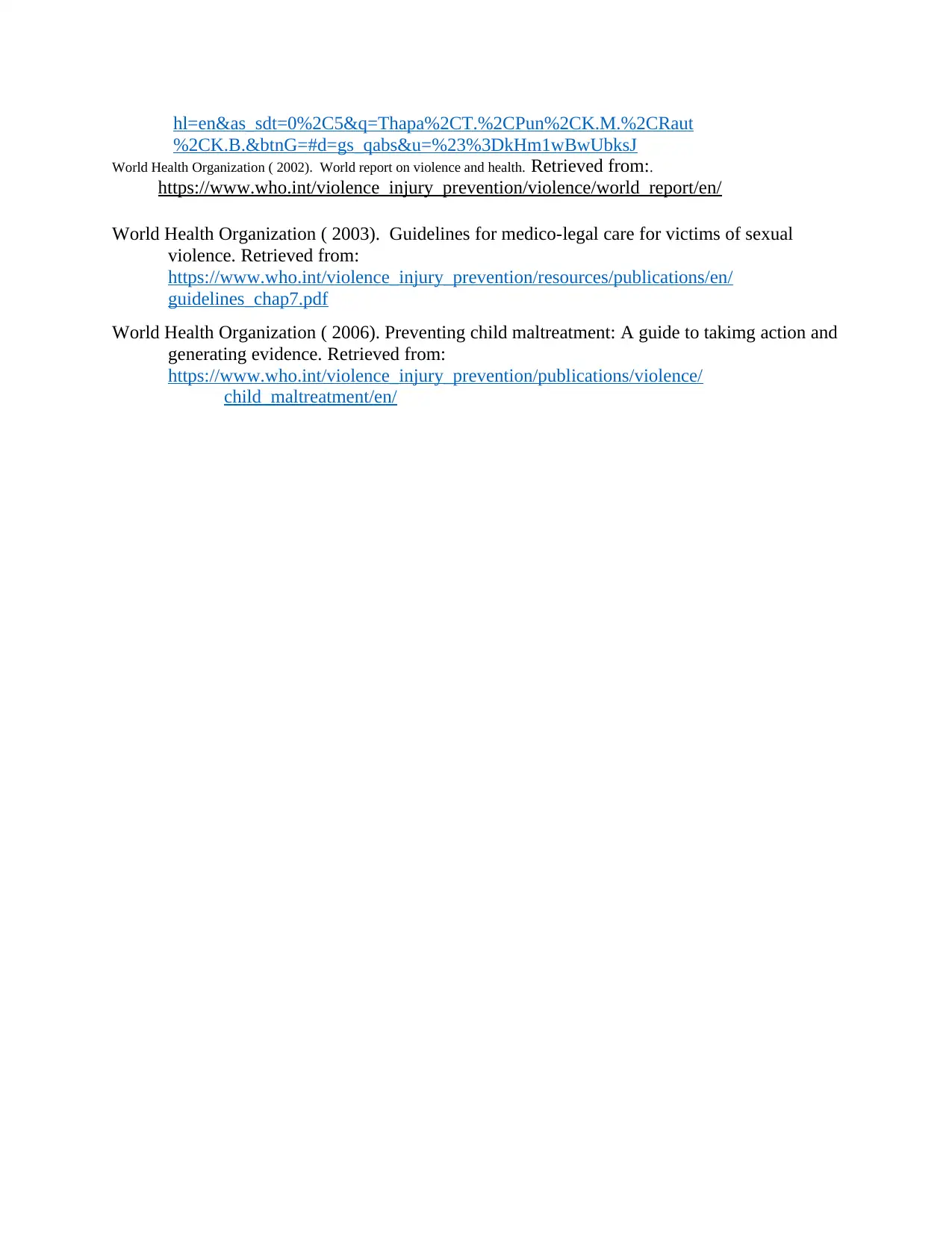
hl=en&as_sdt=0%2C5&q=Thapa%2CT.%2CPun%2CK.M.%2CRaut
%2CK.B.&btnG=#d=gs_qabs&u=%23%3DkHm1wBwUbksJ
World Health Organization ( 2002). World report on violence and health. Retrieved from:.
https://www.who.int/violence_injury_prevention/violence/world_report/en/
World Health Organization ( 2003). Guidelines for medico-legal care for victims of sexual
violence. Retrieved from:
https://www.who.int/violence_injury_prevention/resources/publications/en/
guidelines_chap7.pdf
World Health Organization ( 2006). Preventing child maltreatment: A guide to takimg action and
generating evidence. Retrieved from:
https://www.who.int/violence_injury_prevention/publications/violence/
child_maltreatment/en/
%2CK.B.&btnG=#d=gs_qabs&u=%23%3DkHm1wBwUbksJ
World Health Organization ( 2002). World report on violence and health. Retrieved from:.
https://www.who.int/violence_injury_prevention/violence/world_report/en/
World Health Organization ( 2003). Guidelines for medico-legal care for victims of sexual
violence. Retrieved from:
https://www.who.int/violence_injury_prevention/resources/publications/en/
guidelines_chap7.pdf
World Health Organization ( 2006). Preventing child maltreatment: A guide to takimg action and
generating evidence. Retrieved from:
https://www.who.int/violence_injury_prevention/publications/violence/
child_maltreatment/en/
1 out of 22
Related Documents
Your All-in-One AI-Powered Toolkit for Academic Success.
+13062052269
info@desklib.com
Available 24*7 on WhatsApp / Email
![[object Object]](/_next/static/media/star-bottom.7253800d.svg)
Unlock your academic potential
© 2024 | Zucol Services PVT LTD | All rights reserved.




